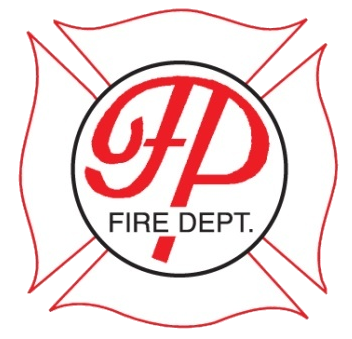Disaster Planning!
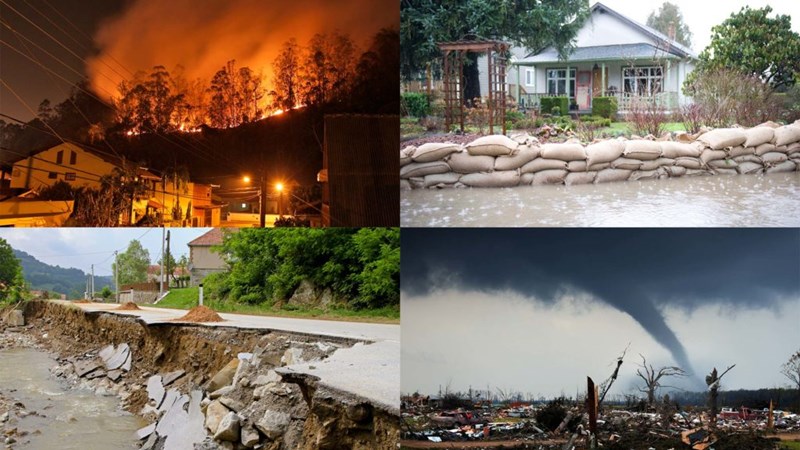
If a Disaster strikes Franklin Park…do you know what to do?
First: Know where to find information and get help. The Village of Franklin Park can offer information through the Fire, Police, Building, Health and Human Services, Engineering, and Public Works Departments. Further, Franklin Park is a proactive community that has a comprehensive Emergency Operations Plan, and has worked closely with Cook County to create and maintain a Hazard Mitigation Plan to help protect and respond to the needs of our community!
Most of the information provided here can be found at www.ready.gov, including activities for Kids!
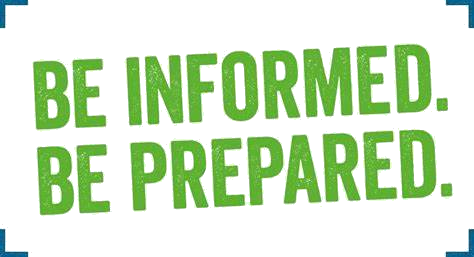
Be Informed
Know what disasters and hazards could affect your area, how to get emergency alerts, and where you would go if you and your family need to evacuate.

Are you part of SMART911?
Over 80% of calls made to 9-1-1 come from mobile phones. When you dial 9-1-1 from a mobile phone, the 9-1-1 call takers have very little information to help you – only your phone number and a very general sense of your location. This could be a serious problem in an emergency when seconds count, particularly if you or your loved ones have medical conditions, or are unable to safely speak.
The new Smart 911 App provides call takers and first responders with the critical information needed in any kind of emergency. Call takers can view your address, medical information, home information, description of pets and vehicles, and emergency contacts. You can provide as much or as little information as you like. Smart 911 is a national service meaning it travels with you and is visible to any participating 9-1-1 center nationwide.
You can also sign up for notifications from the National Weather Service based on your current location, including tornado warnings, flash flood warnings, and severe thunderstorm warnings based on your real time location. You can also include alerts regarding traffic, road closures, Amber alerts, police pursuits and other emergencies. Residents who have registered to receive these alerts can view them even when they don’t have cell service.
Search “Smart 911” in your mobile app store or text “Smart 911” to 67283 to receive the download link via text message.

Public Safety Notifications
The Village of Franklin Park has instituted a new public safety notification call system that allows Village officials to reach thousands of contacts with detailed messages within minutes. This system also allows us to telephone all contacts or only targeted areas of the Village in case of an emergency situation that requires immediate action to help ensure life safety (such as a boil-water notice, missing child, utility outages, chemical spills or evacuation notices).
To provide this service, the Village has contracted with Global Connect. Global Connect is a leading provider of web-based voice messaging, giving us unsurpassed calling speed and capacity without any capital outlay. The system is web-based, so there are no set-up fees, no expensive hardware or software to buy, no maintenance costs, no minimum usage requirements, no training or service fees, and no recording costs to the Village. Voice messaging campaigns can be conducted at any time, from any location - using only a telephone or a web-enabled computer.
This service and support from Global Connect is available 24 hours a day, 7 days a week, 365 days a year to the Village.
Such systems are only as good as the telephone database supporting them:
- If your phone number is not in the database, you will not be called.
- No one's phone number is automatically included.
- It gives individuals and businesses the ability to add their own phone numbers directly to the system's telephone database.
- All businesses should register, as well as all individuals who have unlisted phone numbers, who have changed their phone number or address within the last year, and who use a cellular phone as their primary home phone.
To ensure no one is omitted, we urge all individuals and businesses to complete the registration form located at https://www.villageoffranklinpark.com/departments/police/public_safety_notifications.
Those without Internet access may call the Franklin Park Police Department at (847) 671-8200, Monday through Friday, (8:00am - 3:00pm) to give their information over the phone. Required information includes first and last name, street address (physical address, no P.O. boxes), city, state, zip code, primary phone number. Optional information that can include additional phone numbers (cell phones) and email address.
Emergency Alerts
Public safety officials use timely and reliable systems to alert you and your family in the event of natural or man-made disasters. This page describes different warning alerts you can receive and the types of devices that receive the alerts.
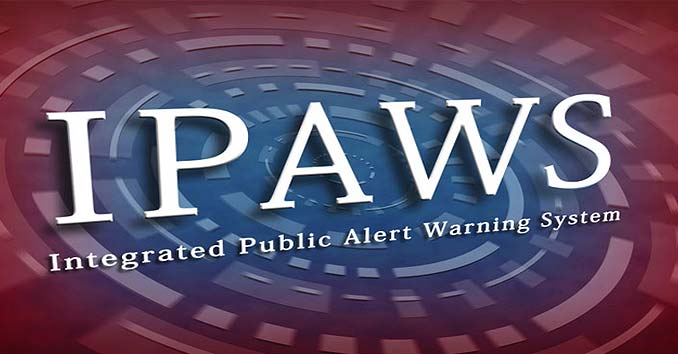
Wireless Emergency Alerts
During an emergency, alert and warning officials need to provide the public with life-saving information quickly. Wireless Emergency Alerts (WEAs), made available through the Integrated Public Alert and Warning System (IPAWS) infrastructure, are just one of the ways public safety officials can quickly and effectively alert and warn the public about serious emergencies.
What you need to know about WEAs:
- WEAs can be sent by state and local public safety officials, the National Weather Service, the National Center for Missing and Exploited Children, and the President of the United States
- WEAs can be issued for three alert categories – imminent threat, AMBER, and presidential
- WEAs look like text messages, but are designed to get your attention and alert you with a unique sound and vibration, both repeated twice
- WEAs are no more than 90 characters, and will include the type and time of the alert, any action you should take, as well as the agency issuing the alert
- WEAs are not affected by network congestion and will not disrupt texts, calls, or data sessions that are in progress
- Mobile users are not charged for receiving WEAs and there is no need to subscribe
- To ensure your device is WEA-capable, check with your service provider
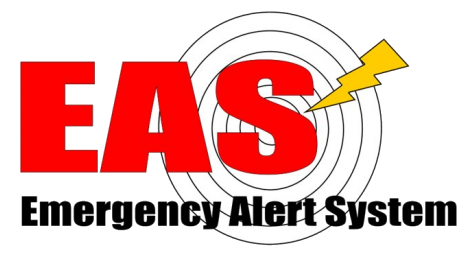
Emergency Alert System
- The Integrated Public Alert and Warning System (IPAWS), is a modernization and integration of the nation's existing and future alert and warning systems, technologies, and infrastructure.
- The Emergency Alert System (EAS) is a national public warning system that requires broadcasters, satellite digital audio service and direct broadcast satellite providers, cable television systems, and wireless cable systems to provide the President with a communications capability to address the American people within 10 minutes during a national emergency.
- EAS may also be used by state and local authorities, in cooperation with the broadcast community, to deliver important emergency information, such as weather information, imminent threats, AMBER alerts, and local incident information targeted to specific areas.
- The President has sole responsibility for determining when the national-level EAS will be activated. FEMA is responsible for national-level EAS tests and exercises.
- EAS is also used when all other means of alerting the public are unavailable, providing an added layer of resiliency to the suite of available emergency communication
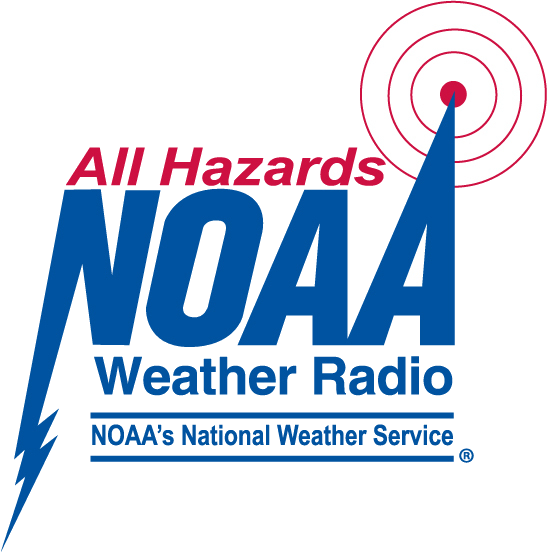
NOAA Weather Radio
NOAA Weather Radio All Hazards (NWR) is a nationwide network of radio stations broadcasting continuous weather information from the nearest National Weather Service office.
- NWR broadcasts official warnings, watches, forecasts and other hazard information 24 hours a day, 7 days a week.
- It also broadcasts alerts of non-weather emergencies such as national security, natural, environmental, and public safety through the Emergency Alert System.
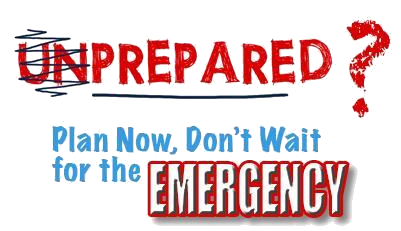
PLAN AHEAD!
Make a plan today. Your family may not be together if a disaster strikes, so it is important to know which types of disasters could affect your area. Know how you’ll contact one another and reconnect if separated. Establish a family meeting place that’s familiar and easy to find.
Step 1: Put together a plan by discussing these 4 questions with your family, friends, or household to start your emergency plan.
- How will I receive emergency alerts and warnings?
- What is my shelter plan?
- What is my evacuation route?
- What is my family/household communication plan?
Step 2: Consider specific needs in your household.
As you prepare your plan tailor your plans and supplies to your specific daily living needs and responsibilities. Discuss your needs and responsibilities and how people in the network can assist each other with communication, care of children, business, pets, or specific needs like the operation of durable medical equipment. Create your own personal network for specific areas where you need assistance. Keep in mind some these factors when developing your plan:
- Different ages of members within your household
- Responsibilities for assisting others
- Locations frequented
- Dietary needs
- Medical needs including prescriptions and equipment
- Disabilities or access and functional needs including devices and equipment
- Languages spoken
- Cultural and religious considerations
- Pets or service animals
- Households with school-aged children
Step 3: Fill out a Family Emergency Plan
Download and fill out a family emergency plan or use them as a guide to create your own.
Step 4: Practice your plan with your family/household
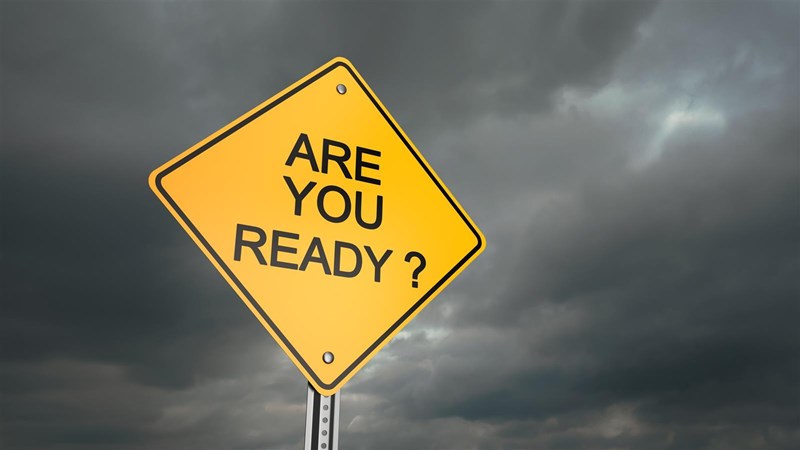
Get Involved
There are many ways to Get Involved especially before a disaster occurs, the content found on this page will guide you find ways to take action in your community. Community leaders agree the formula for ensuring a safer homeland consists of trained volunteers and informed individual taking action to increase the support of emergency response agencies during disasters. Major disasters can overwhelm first responder agencies, empowering individuals to lend support.
Here are some ideas to get you started:
Support your community by participating in FEMA’s individual and community preparedness programs: Citizen Corps, Community Emergency Response Team, Prepareathon, Youth Preparedness.

Until Help Arrives
You Are the Help Until Help Arrives (Until Help Arrives), designed by FEMA, are trainings that can be taken online or in-person, where participants learn to take action and, through simple steps, potentially can save a life before professional help arrives. The program encourages the public to take these five steps when there is an emergency.
- Call 9-1-1;
- Protect the injured from harm;
- Stop bleeding;
- Position the injured so they can breathe; and
- Provide comfort.

Citizen Corps
The Citizen Corps mission is accomplished through a national network of state, local, and tribal Citizen Corps Councils. These Councils build on community strengths to implement the Citizen Corps preparedness programs and carry out a local strategy to involve government, community leaders, and citizens in all-hazards preparedness and resilience.
Citizen Corps asks you to embrace the personal responsibility to be prepared; to get training in first aid and emergency skills; and to volunteer to support local emergency responders, disaster relief, and community safety.
- To learn how you can register for Citizen Corps or find a program near you, please contact your local emergency manager or FEMA at FEMA-Prepare@fema.dhs.gov
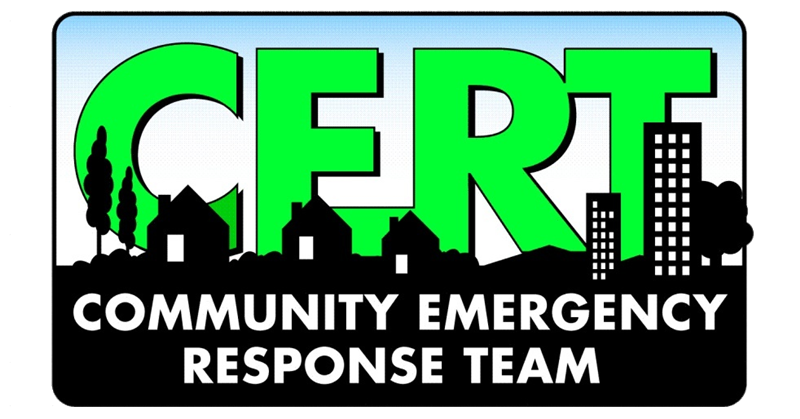
Community Emergency Response Team
Community Emergency Response Team (CERT) program educates individuals about disaster preparedness for hazards that may impact their area and trains them in basic disaster response skills, such as fire safety, light search and rescue, team organization, and disaster medical operations.
Youth Preparedness
As of May 2014, according to the National Center for Education Statistics there is a total of 69.6 million children in school or child care in the United States. Emergencies and disasters can happen at any time, often without warning, where you may not be together with your children.
Starting or getting involved with a youth preparedness program is a great way to enhance a community’s resilience and help develop future generations of prepared adults.
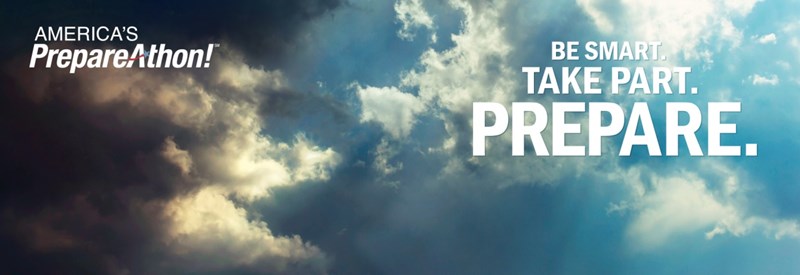
Prepareathon
FEMA’s Prepareathon motivates people and communities to take action to prepare for and protect themselves against disasters. Its chief goals are to increase the number of people who:
- Understand which disasters could affect their community
- Know what to do to stay safe
- Take action to increase preparedness
- Improve their ability to recover from a disaster
- Learn more about Prepareathon
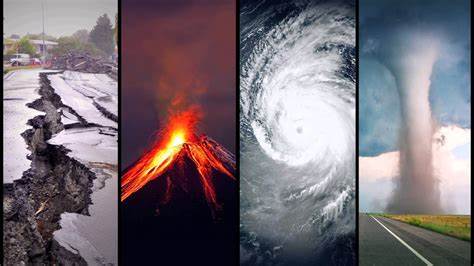
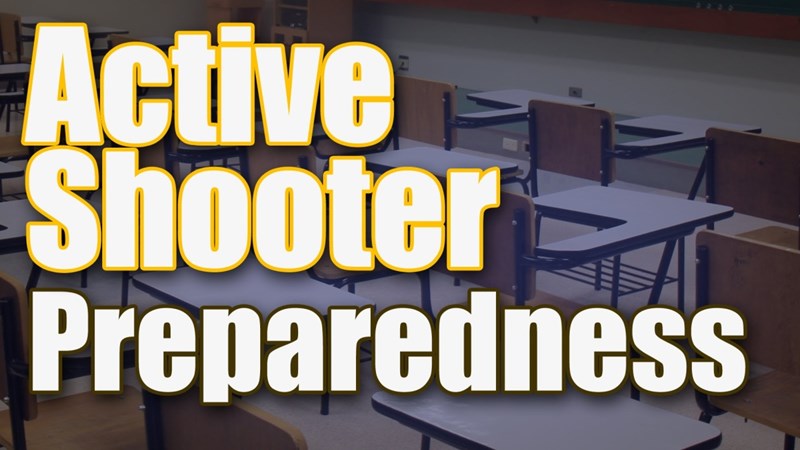
Active Shooter
This describes what to do if you find yourself in an active shooting event, how to recognize signs of potential violence around you, and what to expect after an active shooting takes place. Remember during an active shooting to RUN. HIDE. FIGHT.
Be Informed
- Sign up for active shooter training.
- If you see something, say something to an authority right away.
- Sign up to receive local emergency alerts and register your work and personal contact information with any work sponsored alert system.
- Be aware of your environment and any possible dangers.
Make a Plan
- Make a plan with your family, and ensure everyone knows what they would do, if confronted with an active shooter.
- Look for the two nearest exits anywhere you go, and have an escape path in mind & identify places you could hide.
- Understand the plans for individuals with disabilities or other access and functional needs.
During
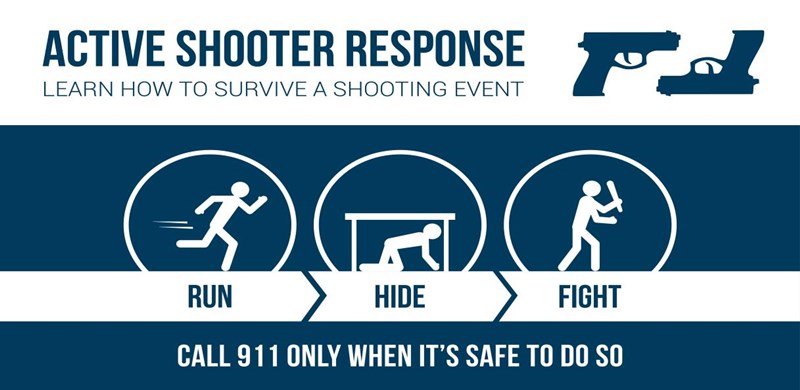
RUN and escape, if possible.
- Getting away from the shooter or shooters is the top priority.
- Leave your belongings behind and get away.
- Help others escape, if possible, but evacuate regardless of whether others agree to follow.
- Warn and prevent individuals from entering an area where the active shooter may be.
- Call 911 when you are safe, and describe shooter, location, and weapons.
HIDE, if escape is not possible.
- Get out of the shooter’s view and stay very quiet.
- Silence all electronic devices and make sure they won’t vibrate.
- Lock and block doors, close blinds, and turn off lights.
- Don’t hide in groups- spread out along walls or hide separately to make it more difficult for the shooter.
- Try to communicate with police silently. Use text message or social media to tag your location, or put a sign in a window.
- Stay in place until law enforcement gives you the all clear.
- Your hiding place should be out of the shooter's view and provide protection if shots are fired in your direction.
FIGHT as an absolute last resort.
- Commit to your actions and act as aggressively as possible against the shooter.
- Recruit others to ambush the shooter with makeshift weapons like chairs, fire extinguishers, scissors, books, etc.
- Be prepared to cause severe or lethal injury to the shooter.
- Throw items and improvise weapons to distract and disarm the shooter.
After
- Keep hands visible and empty.
- Know that law enforcement’s first task is to end the incident, and they may have to pass injured along the way.
- Officers may be armed with rifles, shotguns, and/or handguns and may use pepper spray or tear gas to control the situation.
- Officers will shout commands and may push individuals to the ground for their safety.
- Follow law enforcement instructions and evacuate in the direction they come from, unless otherwise instructed.
- Take care of yourself first, and then you may be able to help the wounded before first responders arrive.
- If the injured are in immediate danger, help get them to safety.
- While you wait for first responders to arrive, provide first aid. Apply direct pressure to wounded areas and use tourniquets if you have been trained to do so.
- Turn wounded people onto their sides if they are unconscious and keep them warm.
- Consider seeking professional help for you and your family to cope with the long-term effects of the trauma.
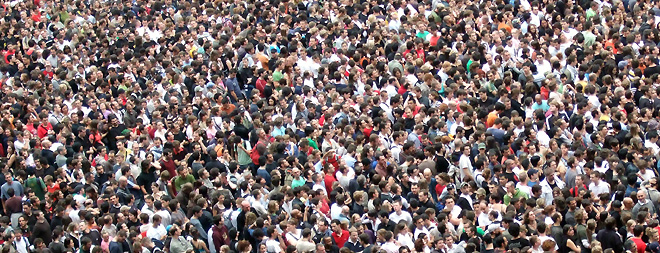
Mass Attacks in Crowded & Public Spaces
While the threat of mass attacks is real, we can all take steps to prepare, protect ourselves, and help others.
What are Mass Attacks?
Assailant(s):
- Use weapons to attack crowds
- Target less protected indoor or outdoor spaces
- Intend to harm multiple victims
- Use the attack(s) to intimidate
- Can use makeshift or modern weapons
Types of Mass Attacks
- Active shooter: Individuals using firearms to cause mass casualties.
- Intentional Vehicular Assault (IVA): Individuals using a vehicle to cause mass casualties.
- Improvised Explosive Device (IED): Individuals using homemade bombs to cause mass casualties.
- Other methods of mass attacks may include knives, fires, drones, or other weapons.
Protect Yourself Against a Mass Attack
- Stay alert
- Seek safety
- Cover and hide
- Defend yourself
- Help the wounded
If You See Something, Say Something®
Report suspicious behavior, items, or activities to authorities.
Observe warning signs
Signs might include unusual or violent communications, expressed anger or intent to cause harm, and substance abuse. These warning signs may increase over time.
Be alert to your surroundings
Observe what is going on around you and avoid distractions such as texting, listening to headphones or being on your cell phone.
Have an exit plan
Identify exits and areas of protective cover for the places you go such as work, school, and special events.
Plan to seek cover for protection
Map out places to seek cover. Place a barrier between yourself and the threat using solid objects, walls, and locked doors as protection.
Learn lifesaving skills
Take trainings such as You Are the Help Until Help Arrives and first aid to assist the wounded before help arrives.
How to Stay Safe When a Mass Attack Threatens
Prepare NOW
Be alert to your surroundings. If You See Something, Say Something®:
Observe warning signs:
- Unusual or threatening communications.
- Expressed grievances related to a workplace, personal, or other issues.
- Ideologies promoting violence.
- Suspicious behavior such as excessive questioning or attention to security details.
- Unusual items or packages.
Know exits and areas to cover and hide
- When visiting new places, take time to identify at least two nearby exits.
- Identify areas in familiar places, such as work, school, and outdoor events where you could hide and seek protective cover in case of attack.
Be ready to help
- Learn and practice skills such as casualty care, CPR, and first aid. Teach others.
- Organize and participate in safety drills in places where people gather like home, school, and work.
Survive DURING
Stay alert
- Pay attention to what is happening around you so that you can react quickly to attacks.
Run to safety
- If there is an accessible escape path, attempt to evacuate the building or area, regardless of whether others agree to follow.
Cover and hide
- If evacuation is not possible, find a place to hide out of view of the attacker and if possible, put a solid barrier between yourself and the threat.
- Keep silent.
Defend, disrupt, fight
- As a last resort, when you can’t run or cover, attempt to disrupt the attack and/or incapacitate the attacker.
- Be aggressive and commit to your actions.
Help the wounded
- Take care of yourself first and then, if you are able, help the wounded get to safety and provide immediate first care.
Be Safe AFTER
Call 9-1-1
- When you are safe, call 9-1-1 and be prepared to provide information to the operator including location of the incident, number of injured, and details about the attacker(s).
Continue lifesaving assistance
- If you are able, continue to provide care until first responders arrive.
When law enforcement arrives
- Remain calm and follow instructions.
- Keep hands visible and empty.
- Report to designated area to provide information and get help.
Monitor communications
- Listen to law enforcement’s messages for information about the situation. Share updates with family and friends.
Consider seeking professional help
- Be mindful of your health. If needed, seek help for you and your family to cope with the trauma.
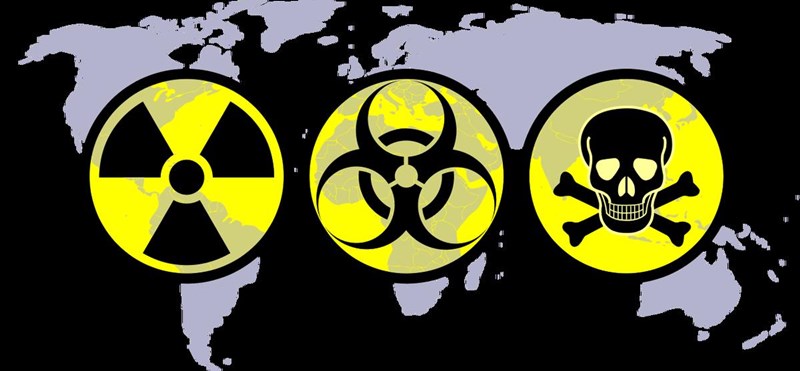
Bioterrorism
Biological agents are organisms or toxins that can kill or incapacitate people, livestock and crops. A biological attack is the deliberate release of germs or other biological substances that can make you sick.
There are three basic groups of biological agents that could likely be used as weapons: bacteria, viruses and toxins. Biological agents can be dispersed by spraying them into the air, person-to-person contact, infecting animals that carry the disease to humans and by contaminating food and water.
Before a Biological Threat
A biological attack may or may not be immediately obvious. In most cases local health care workers will report a pattern of unusual illness or there will be a wave of sick people seeking emergency medical attention. The public would be alerted through an emergency radio or TV broadcast, or some other signal used in your community, such as a telephone call or a home visit from an emergency response worker.
The following are things you can do to protect yourself, your family and your property from the effects of a biological threat:
- Build an Emergency Supply Kit
- Make a Family Emergency Plan
- Check with your doctor to ensure all required or suggested immunizations are up to date for yourself, your children and elderly family members.
- Consider installing a High-Efficiency Particulate Air (HEPA) filter in your furnace return duct, which will filter out most biological agents that may enter your house
During a Biological Threat
The first evidence of an attack may be when you notice symptoms of the disease caused by exposure to an agent. In the event of a biological attack, public health officials may not immediately be able to provide information on what you should do. It will take time to determine exactly what the illness is, how it should be treated, and who is in danger.
Follow these guidelines during a biological threat:
- Watch TV, listen to the radio, or check the Internet for official news and information including signs and symptoms of the disease, areas in danger, if medications or vaccinations are being distributed and where you should seek medical attention if you become ill.
- If you become aware of an unusual and suspicious substance, quickly get away.
- Cover your mouth and nose with layers of fabric that can filter the air but still allow breathing. Examples include two to three layers of cotton such as a t-shirt, handkerchief or towel.
- Depending on the situation, wear a face mask to reduce inhaling or spreading germs.
- If you have been exposed to a biological agent, remove and bag your clothes and personal items. Follow official instructions for disposal of contaminated items.
- Wash yourself with soap and water and put on clean clothes.
- Contact authorities and seek medical assistance. You may be advised to stay away from others or even quarantined.
- If your symptoms match those described and you are in the group considered at risk, immediately seek emergency medical attention.
- Follow instructions of doctors and other public health officials.
- If the disease is contagious expect to receive medical evaluation and treatment.
- For non-contagious diseases, expect to receive medical evaluation and treatment.
- In a declared biological emergency or developing epidemic avoid crowds
- Wash your hands with soap and water frequently.
- Do not share food or utensils.
After a Biological Threat
Pay close attention to all official warnings and instructions on how to proceed. The delivery of medical services for a biological event may be handled differently to respond to increased demand.
The basic public health procedures and medical protocols for handling exposure to biological agents are the same as for any infectious disease. It is important for you to pay attention to official instructions via radio, television, and emergency alert systems.
Visit the Centers for Disease Control and Prevention for a complete list of potential agents/diseases and appropriate treatments.
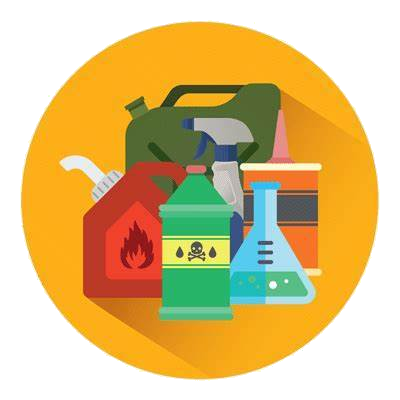
Chemical Emergencies
Chemical agents are poisonous vapors, aerosols, liquids and solids that have toxic effects on people, animals or plants. While potentially lethal, chemical agents are difficult to deliver in lethal concentrations because they dissipate rapidly outdoors and are difficult to produce.
Before a Chemical Emergency
A chemical attack could come without warning. Signs of a chemical release include people having difficulty breathing, eye irritation, loss of coordination, nausea, or burning in the nose, throat and lungs. The presence of many dead insects or birds may indicate a chemical agent release.
What you should do to prepare for a chemical threat:
During a Chemical Emergency
What you should do in a chemical attack:
- Quickly try to define the impacted area or where the chemical is coming from, if possible.
- Take immediate action to get away.
- If the chemical is inside a building where you are, get out of the building without passing through the contaminated area, if possible.
- If you can't get out of the building or find clean air without passing through the affected area, move as far away as possible and shelter-in-place.
If you are instructed to remain in your home or office building, you should:
- Close doors and windows and turn off all ventilation, including furnaces, air conditioners, vents, and fans.
- Seek shelter in an internal room with your disaster supplies kit.
- Seal the room with duct tape and plastic sheeting.
- Listen to the radio or television for instructions from authorities.
If you are caught in or near a contaminated area outdoors:
- Quickly decide what is the fastest way to find clean air:
- Move away immediately, in a direction upwind of the source.
- Find the closest building to shelter-in-place.
After a Chemical Emergency
Do not leave the safety of a shelter to go outdoors to help others until authorities announce it is safe to do so.
A person affected by a chemical agent requires immediate medical attention from a professional. If medical help is not immediately available, decontaminate yourself and assist in decontaminating others.
Decontamination guidelines are as follows:
- Use extreme caution when helping others who have been exposed to chemical agents.
- Remove all clothing and other items in contact with the body.
- Cut off clothing normally removed over the head to avoid contact with the eyes, nose and mouth.
- Put contaminated clothing and items into a plastic bag and seal it.
- Remove eyeglasses or contact lenses. Put glasses in a pan of household bleach to decontaminate them and then rinse and dry.
- Wash hands with soap and water.
- Flush eyes with water.
- Gently wash face and hair with soap and water before thoroughly rinsing with water.
- Proceed to a medical facility for screening and professional treatment.

Cybersecurity
Cybersecurity involves preventing, detecting, and responding to cyberattacks that can have wide ranging effects on the individual, organizations, the community, and at the national level. Cyberattacks are malicious attempts to access or damage a computer system. Cyberattacks can lead to loss of money, theft of personal information, and damage to your reputation and safety. Cyberattacks are malicious attempts to access or damage a computer system.
Cyberattacks:
- Can use computers, mobile phones, gaming systems, and other devices;
- Can include identity theft;
- Can block your access or delete your personal documents and pictures;
- Can target children; and
- Can cause problems with business services, transportation, and power.
Protect Yourself Against a Cyberattack
- Keep software and operating systems up-to-date
- Use strong passwords and two-factor authentication (two methods of verification).
- Watch for suspicious activity. When in doubt, don't click. Do not provide personal information.
- Use encrypted (secure) internet communications.
- Create backup files.
- Protect your home and/or business WiFi network.
Before a Cyberattack
You can increase your chances of avoiding cyber risks by setting up the proper controls. The following are things you can do to protect yourself, your family, and your property before a cyberattack occurs:
- Use strong passwords that are 12 characters or longer. Use upper and lowercase letters, numbers, and special characters. Change passwords monthly. Use a password manager.
- Use a stronger authentication such as a PIN or password that only you would know. Consider using a separate device that can receive a code or uses a biometric scan (e.g., fingerprint scanner).
- Watch for suspicious activity that asks you to do something right away, offers something that sounds too good to be true, or needs your personal information. Think before you click.
- Check your account statements and credit reports regularly.
- Use secure internet communications.
- Use sites that use HTTPS if you will access or provide any personal information. Do not use sites with invalid certificates. Use a Virtual Private Network (VPN) that creates a secure connection.
- Use antivirus solutions, malware, and firewalls to block threats.
- Regularly back up your files in an encrypted file or encrypted file storage device.
- Limit the personal information you share online. Change privacy settings and do not use location features.
- Protect your home network by changing the administrative and Wi-Fi passwords regularly. When configuring your router, choose the Wi-Fi Protected Access 2 (WPA2) Advanced Encryption Standard (AES) setting, which is the strongest encryption option.
During a Cyberattack
At Home
- Limit the damage. Look for unexplained charges, strange accounts on your credit report, unexpected denial of your credit card, posts you did not make showing up on your social networks and people receiving emails you never sent.
- Immediately change passwords for all of your online accounts.
- Scan and clean your device.
- Consider turning off the device. Take it to a professional to scan and fix.
- Let work, school, or other system owners know. Information
- Contact banks, credit card companies, and other financial accounts. You may need to place holds on accounts that have been attacked. Close any unauthorized credit or charge accounts. Report that someone may be using your identity.
- Check to make sure the software on all of your systems is up-to-date.
- Run a scan to make sure your system is not infected or acting suspiciously.
- If you find a problem, disconnect your device from the Internet and perform a full system restore.
- If in a public setting immediately inform a librarian, teacher, or manager in charge to contact their IT department.
After a Cyberattack
- File a report with the Office of the Inspector General (OIG) if you think someone is illegally using your Social Security number. OIG reviews cases of waste, fraud, and abuse. To file a report, visit www.idtheft.gov.
- You can also call the Social Security Administration hotline at 1-800-269- 0271. For additional resources and more information, visit http://oig.ssa.gov/report.
- File a complaint with the FBI Internet Crime Complaint Center (IC3) at www.IC3.gov. They will review the complaint and refer it to the appropriate agency.
- Learn tips, tools, and more at www.dhs.gov/stopthinkconnect.
- File a report with the local police so there is an official record of the incident.
- Report identity theft to the Federal Trade Commission.
- Contact additional agencies depending on what information was stolen. Examples include contacting the Social Security Administration if you social security number was compromised, or the Department of Motor Vehicles if your driver's license or car registration has been stolen.
- Report online crime or fraud to your local United States Secret Service (USSS) Electronic Crimes Task Force or the Internet Crime Complaint Center.
- For further information on preventing and identifying threats, visit US-CERT’s Alerts and Tips page.

Drought
Nearly every part of our country experiences periods of reduced rainfall. If we plan for drought, then we can enjoy the benefits of normal or rainy years and not get caught unprepared in dry years.
Before a Drought
Strategies for drought preparedness focus mainly on water conservation. Make these practices a part of your daily life and help preserve this essential resource.
Indoor Water Conservation Tips Prior to a Drought
GENERAL
- Never pour water down the drain when there may be another use for it. For example, use it to water your indoor plants or garden.
- Repair dripping faucets by replacing washers. One drop per second wastes 2,700 gallons of water per year.
- Check all plumbing for leaks and have any leaks repaired by a plumber.
- Retrofit all household faucets by installing aerators with flow restrictors.
- Install an instant hot water heater on your sink.
- Insulate your water pipes to reduce heat loss and prevent them from breaking.
- Install a water-softening system only when the minerals in the water would damage your pipes. Turn the softener off while on vacation.
- Choose appliances that are more energy and water efficient.
BATHROOM
- Consider purchasing a low-volume toilet that uses less than half the water of older models. Note: In many areas, low-volume units are required by law.
- Install a toilet displacement device to cut down on the amount of water needed to flush. Place a one-gallon plastic jug of water into the tank to displace toilet flow (do not use a brick, it may dissolve and loose pieces may cause damage to the internal parts). Be sure installation does not interfere with the operating parts.
- Replace your showerhead with an ultra-low-flow version.
KITCHEN
- Start a compost pile as an alternate method of disposing of food waste or simply dispose of food in the garbage. (Kitchen sink disposals require a lot of water to operate properly).
Outdoor Water Conservation Tips Prior to a Drought
GENERAL
- Check your well pump periodically. If the automatic pump turns on and off while water is not being used, you have a leak.
- Plant native and/or drought-tolerant grasses, ground covers, shrubs, and trees. Once established, plants adapted to your local climate do not need water as frequently and usually will survive a dry period without watering. Small plants require less water to become established. Group plants together based on similar water needs.
- Install irrigation devices that are the most water efficient for each use, such as micro and drip irrigation, and soaker hoses.
- Use mulch to retain moisture in the soil. Mulch also helps control weeds that compete with landscape plants for water.
- Avoid purchasing recreational water toys that require a constant stream of water.
- Avoid installing ornamental water features (such as fountains) unless they use re-circulated water.
- Consider rainwater harvesting where practical.
- Contact your local water provider for information and assistance.
LAWN CARE
- Position sprinklers so water lands on the lawn and shrubs and not on paved areas.
- Repair sprinklers that spray a fine mist. Most misting issues result from a pressure problem, properly regulating pressure in an irrigation system will prevent misting.
- Check sprinkler systems and timing devices regularly to be sure they operate properly.
- Raise the lawn mower blade to at least three inches or to its highest level. A higher cut encourages grass roots to grow deeper, shades the root system, and holds soil moisture.
- Plant drought-resistant lawn seed. Reduce or eliminate lawn areas that are not used frequently.
- Avoid over-fertilizing your lawn. Applying fertilizer increases the need for water. Apply fertilizers that contain slow-release, water-insoluble forms of nitrogen.
- Choose a water-efficient irrigation system such as drip irrigation for your trees, shrubs, and flowers.
- Turn irrigation down in fall and off in winter. Water manually in winter only if needed.
- Put a layer of mulch around trees and plants to reduce evaporation and keep the soil cool. Organic mulch also improves the soil and prevents weeds.
- Invest in a weather-based irrigation controller—or a smart controller. These devices will automatically adjust the watering time and frequency based on soil moisture, rain, wind, and evaporation and transpiration rates. Check with your local water agency to see if there is a rebate available for the purchase of a smart controller.
POOL
- Install a new water-saving pool filter. A single back flushing with a traditional filter uses 180 to 250 gallons of water.
- Cover pools and spas to reduce evaporation of water.
During a Drought
Always observe state and local restrictions on water use during a drought. If restricted, for example, do not water your lawn, wash your car, or other non-essential uses, to help ensure there is enough water for essential uses. Contact your state or local government for current information and suggestions.
Indoor Water Conservation Tips While in a Drought
BATHROOM
- Avoid flushing the toilet unnecessarily. Dispose of tissues, insects, and other similar waste in the trash rather than the toilet.
- Avoid taking baths—take short showers—turn on water only to get wet and lather and then again to rinse off.
- Avoid letting the water run while brushing your teeth, washing your face or shaving.
- Place a bucket in the shower to catch excess water for watering plants.
KITCHEN
- Operate automatic dishwashers only when they are fully loaded. Use the "light wash" feature, if available, to use less water.
- Hand wash dishes by filling two containers—one with soapy water and the other with rinse water containing a small amount of chlorine bleach.
- Clean vegetables in a pan filled with water rather than running water from the tap.
- Store drinking water in the refrigerator. Do not let the tap run while you are waiting for water to cool.
- Avoid wasting water waiting for it to get hot. Capture it for other uses such as plant watering or heat it on the stove or in a microwave.
- Avoid rinsing dishes before placing them in the dishwasher; just remove large particles of food. (Most dishwashers can clean soiled dishes very well, so dishes do not have to be rinsed before washing)
- Avoid using running water to thaw meat or other frozen foods. Defrost food overnight in the refrigerator or use the defrost setting on your microwave oven.
LAUNDRY
- Operate automatic clothes washers only when they are fully loaded or set the water level for the size of your load.
Outdoor Water Conservation Tips While in a Drought
CAR WASHING
- Use a commercial car wash that recycles water.
- If you wash your own car, use a shut-off nozzle that can be adjusted down to a fine spray on your hose.
LAWN CARE
- Avoid over watering your lawn and water only when needed:
- A heavy rain eliminates the need for watering for up to two weeks. Most of the year, lawns only need one inch of water per week.
- Check the soil moisture levels with a soil probe, spade or large screwdriver. You don't need to water if the soil is still moist. If your grass springs back when you step on it, it doesn't need water yet.
- If your lawn does require watering, do so early in the morning or later in the evening, when temperatures are cooler.
- Check your sprinkler system frequently and adjust sprinklers so only your lawn is watered and not the house, sidewalk, or street.
- Water in several short sessions rather than one long one, in order for your lawn to better absorb moisture and avoid runoff.
- Use a broom or blower instead of a hose to clean leaves and other debris from your driveway or sidewalk.
- Avoid leaving sprinklers or hoses unattended. A garden hose can pour out 600 gallons or more in only a few hours.
- In extreme drought, allow lawns to die in favor of preserving trees and large shrub
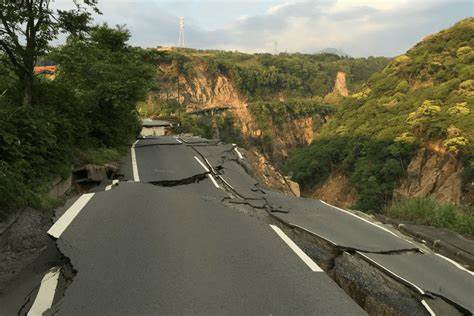
Earthquakes
An earthquake is the sudden, rapid shaking of the earth, caused by the breaking and shifting of underground rock. Earthquakes can cause buildings to collapse and cause heavy items to fall, resulting in injuries and property damage.
Earthquakes can:
- Happen anywhere. Higher risk areas include California, Oregon, Washington, Alaska, Hawaii, Puerto Rico and the Mississippi Valley.
- Happen without warning.
- Cause fires and damage roads.
- Cause tsunamis, landslides and avalanches.
If an earthquake happens, protect yourself right away. Drop, Cover and Hold On!
- If you are in a vehicle, pull over and stop. Set your parking brake.
- If you are in bed, turn face down and cover your head and neck with a pillow.
- If you are outdoors, stay outdoors away from buildings.
- Do not get in a doorway.
- Do not run outside.
- Visit EarthquakeCountry.org/step5 for tips and videos on what to do in a variety of other situations.
Stay Safe During an Earthquake: Drop, Cover and Hold On!
Drop: Drop where you are, onto your hands and knees.
Cover: Cover your head and neck with your arms. If a sturdy table or desk is nearby, crawl underneath it for shelter. If no shelter is nearby, crawl next to an interior wall (away from windows). Crawl only if you can reach better cover without going through an area with more debris. Stay on your knees; bend over to protect vital organs,
Hold On. If you are under a table or desk, hold onto with one hand and be ready to move with it if it moves. If you can’t find a table or desk: hold on to your head and neck with both arms and hands. If seated and unable to drop to the floor: bend forward, cover your head with your arms, and hold on to your neck with both hands.
If using a wheelchair or a walker with a seat:
Lock: Make sure your wheels are locked. Remain seated until the shaking stops.
Cover: Protect your head and neck with your arms, a pillow, a book, or whatever is available.
Hold on: maintain your position with head and neck covered until shaking stops.
Prepare Before an Earthquake
The best time to prepare for any disaster is before it happens.
- Practice Drop, Cover, then Hold On with family and coworkers. Drop to your hands and knees. Cover your head and neck with your arms. Crawl under a sturdy table or desk if nearby. Hold on to any sturdy furniture until the shaking stops. If a table or desk is not close, crawl next to an interior wall.
- Secure items, such as bookcases, refrigerators, televisions and objects that hang on walls. Store heavy and breakable objects on low shelves.
- Create a family emergency communications plan that has an out-of-state contact. Plan where to meet if you get separated.
- Make a supply kit that includes enough food and water for at least three days, a flashlight, a fire extinguisher, and a whistle. Consider each person’s specific needs, including medication. Have extra batteries and charging devices for phones and other critical equipment. Do not forget the needs of pets and service animals.
- Consider obtaining an earthquake insurance policy. A standard homeowner’s insurance policy does not cover earthquake damage.
- Consider making improvements to your building to fix structural issues that could cause your building to collapse during an earthquake.
Keep Yourself Safe After an Earthquake
If an earthquake has just happened, there can be serious hazards such as damage to the building, leaking gas and water lines, or downed power lines.
- Expect aftershocks to follow the main shock of an earthquake.
- Check yourself to see if you are hurt and help others if you have training. Learn how to be the Help Until Help Arrives (Link to: https://community.fema.gov/until-help-arrives)
- If you are in a damaged building, go outside and quickly move away from the building.
- Do not enter damaged buildings.
- If you are trapped, protect your mouth, nose and eyes from dust. Send a text, bang on a pipe or wall, or use a whistle instead of shouting so that rescuers can locate you.
- If you are in an area that may experience tsunamis, go inland or to higher ground immediately after the shaking stops.
- Text messages may be more reliable than phone calls. Save phone calls for emergencies.
- Once you are safe, listen to local news reports via battery operated radio, TV, social media, and cell phone text alerts for emergency information and instructions. Be very careful during post-disaster clean-up of buildings and around debris. Do not attempt to remove heavy debris by yourself. Wear protective clothing, including a long-sleeved shirt, long pants, work gloves, and sturdy, thick-soled shoes during clean-up.
- Register on the Red Cross “Safe and Well” website so people will know you are okay: SafeAndWell.org.

Explosions
Explosive devices can be highly portable, using vehicles and humans as a means of transport. They are easily detonated from remote locations or by suicide bombers. There are steps you can take to prepare for the unexpected.
Before an Explosion
The following are things you can do to protect yourself, your family and your property in the event of an explosion.
- Build an Emergency Supply Kit
- Make a Family Emergency Plan
- Learn what to do in case of bomb threats or receiving suspicious packages and letters
- Ensure your employers have up-to-date information about any medical needs you may have and how to contact designated beneficiaries or emergency contacts.
Bomb Threats
If you receive a telephoned bomb threat:
- Get as much information from the caller as possible. Try to ask the following questions:
- When is the bomb going to explode?
- Where is it right now?
- What does it look like?
- What kind of bomb is it?
- What will cause it to explode?
- Did you place the bomb?
- Keep the caller on the line and record everything that is said.
- Notify the police and building management immediately.
Suspicious Packages and Letters
Some typical characteristics postal inspectors have detected over the years, which should trigger suspicion, include parcels that:
- Are unexpected or from someone unfamiliar to you.
- Have no return address, one that doesn’t match the postmark, or can’t be verified as legitimate.
- Are marked with restrictive endorsements such as “Personal,” “Confidential,” or “Do not X-ray.”
- Have inappropriate or unusual labeling such as threatening language
- Have protruding wires or aluminum foil, strange odors or stains.
- Have excessive postage or packaging material, such as masking tape and string.
- Are of unusual weight given their size or are lopsided or oddly shaped.
- Are not addressed to a specific person.
Take these additional steps against possible biological and chemical agents:
- Never sniff or smell suspicious mail.
- Place suspicious envelopes or packages in a plastic bag or some other type of container to prevent leakage of contents.
- Leave the room and close the door or section off the area to prevent others from entering.
- Wash your hands with soap and water to prevent spreading any powder to your face.
- If you are at work, report the incident to your building security official or an available supervisor, who should notify police and other authorities without delay.
- List all people who were in the room or area when this suspicious letter or package was recognized. Give a copy of this list to both the local public health authorities and law enforcement officials for follow-up investigations and advice.
- If you are at home, report the incident to local police.
During an Explosion
- Get under a sturdy table or desk if things are falling around you. When they stop falling, leave quickly, watching for obviously weakened floors and stairways.
- Do not use elevators.
- Stay low if there is smoke. Do not stop to retrieve personal possessions or make phone calls.
- Check for fire and other hazards.
- Once you are out, do not stand in front of windows, glass doors or other potentially hazardous areas.
- If you are trapped in debris, use a flashlight, whistle or tap on pipes to signal your location to rescuers.
- Shout only as a last resort to avoid inhaling dangerous dust.
- Cover your nose and mouth with anything you have on hand.
After an Explosion
- There may be significant numbers of casualties or damage to buildings and infrastructure.
- Heavy law enforcement involvement at local, state and federal levels.
- Health and mental health resources in the affected communities can be strained to their limits, maybe even overwhelmed.
- Extensive media coverage, strong public fear and international implications and consequences.
- Workplaces and schools may be closed, and there may be restrictions on domestic and international travel.
- You and your family or household may have to evacuate an area, avoiding roads blocked for your safety.
- Clean-up may take many months.
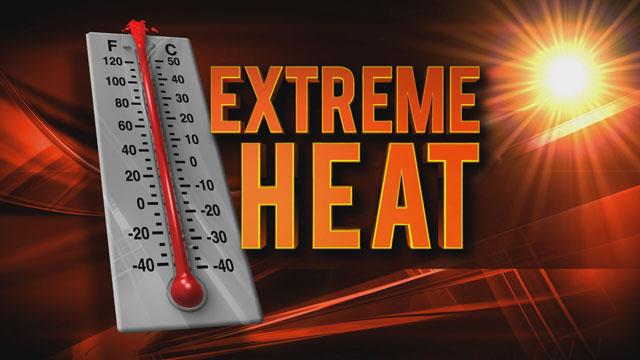
Extreme Heat
Extreme Heat often results in the highest number of annual deaths among all weather-related hazards. In most of the United States, extreme heat is defined as a long period (2 to 3 days) of high heat and humidity with temperatures above 90 degrees. In extreme heat, evaporation is slowed and the body must work extra hard to maintain a normal temperature. This can lead to death by overworking the human body. Remember that:
- Extreme heat can occur quickly and without warning.
- Older adults, children, and sick or overweight individuals are at greater risk from extreme heat.
- Humidity increases the feeling of heat as measured by a heat index.
IF YOU ARE UNDER AN EXTREME HEAT WARNING:
- Find air conditioning.
- Avoid strenuous activities.
- Watch for heat illness.
- Wear light clothing.
- Check on family members and neighbors.
- Drink plenty of fluids.
- Watch for heat cramps, heat exhaustion, and heat stroke.
- Never leave people or pets in a closed car.
HOW TO STAY SAFE WHEN EXTREME HEAT THREATENS
Prepare NOW
- Find places in your community where you can go to get cool.
- Keep your home cool by doing the following:
- Cover windows with drapes or shades.
- Weather-strip doors and windows.
- Use window reflectors, such as aluminum foil-covered cardboard, to reflect heat back outside.
- Add insulation to keep the heat out.
- Use attic fans to clear hot air.
- Install window air conditioners and insulate around them.
- Learn to recognize the signs of heat-related illness.
Be Safe DURING
- Never leave a child, adult, or animal alone inside a vehicle on a warm day.
- Find places with air conditioning. Libraries, shopping malls, and community centers can provide a cool place to take a break from the heat.
- If you’re outside, find shade. Wear a hat wide enough to protect your face.
- Wear loose, lightweight, light-colored clothing.
- Drink plenty of fluids to stay hydrated. If you or someone you care for is on a special diet, ask a doctor how best to accommodate it.
- Do not use electric fans when the temperature outside is more than 95 degrees, as this could increase the risk of heat-related illness. Fans create air flow and a false sense of comfort, but do not reduce body temperature.
- Avoid high-energy activities.
- Check yourself, family members, and neighbors for signs of heat-related illness.
RECOGNIZE AND RESPOND
Know the signs of heat-related illness and the ways to respond to it:
- HEAT CRAMPS
- Signs: Muscle pains or spasms in the stomach, arms, or legs
- Actions: Go to a cooler location. Remove excess clothing. Take sips of cool sports drinks with salt and sugar. Get medical help if cramps last more than an hour.
- HEAT EXHAUSTION
- Signs: Heavy sweating, paleness, muscle cramps, tiredness, weakness, dizziness, headache, nausea or vomiting, or fainting
- Actions: Go to an air-conditioned place and lie down. Loosen or remove clothing. Take a cool bath. Take sips of cool sports drinks with salt and sugar. Get medical help if symptoms get worse or last more than an hour.
- HEAT STROKE
- Signs: Extremely high body temperature (above 103 degrees) taken orally; red, hot, and dry skin with no sweat; rapid, strong pulse; dizziness; confusion; or unconsciousness
- Actions: Call 911 or get the person to a hospital immediately. Cool down with whatever methods are available until medical help arrives.

Floods
Failing to evacuate flooded areas, entering flood waters, or remaining after a flood has passed can result in injury or death. Flooding is a temporary overflow of water onto land that is normally dry. Floods are the most common natural disaster in the United States. Floods may:
- Result from rain, snow, coastal storms, storm surges, and overflows of dams and other water systems.
- Develop slowly or quickly – Flash floods can come with no warning.
- Cause outages, disrupt transportation, damage buildings, and create landslides.
IF YOU ARE UNDER A FLOOD WARNING, FIND SAFE SHELTER RIGHT AWAY
- Do not walk, swim, or drive through flood waters. Turn Around, Don’t Drown!
- Just six inches of moving water can knock you down, and one foot of moving water can sweep your vehicle away.
- Stay off of bridges over fast-moving water.
- Determine how best to protect yourself based on the type of flooding.
- Evacuate if told to do so.
- Move to higher ground or a higher floor.
- Stay where you are.
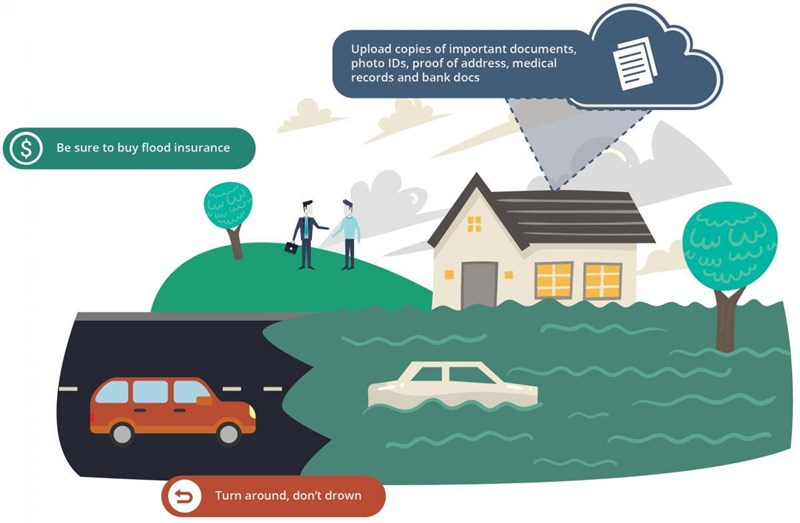
HOW TO STAY SAFE WHEN A FLOOD THREATENS
Prepare NOW
- Know types of flood risk in your area. Visit FEMA’s Flood Map Service Center for information.
- Sign up for your community’s warning system. The Emergency Alert System (EAS) and National Oceanic and Atmospheric Administration (NOAA) Weather Radio also provide emergency alerts.
- If flash flooding is a risk in your location, then monitor potential signs, such as heavy rain.
- Learn and practice evacuation routes, shelter plans, and flash flood response.
- Gather supplies in case you have to leave immediately, or if services are cut off. Keep in mind each person’s specific needs, including medication. Don’t forget the needs of pets. Obtain extra batteries and charging devices for phones and other critical equipment.
- Purchase or renew a flood insurance policy. It typically takes up to 30 days for a policy to go into effect and can protect the life you've built. Homeowner’s policies do not cover flooding. Get flood coverage under the National Flood Insurance Program (NFIP)
- Keep important documents in a waterproof container. Create password-protected digital copies.
- Protect your property. Move valuables to higher levels. Declutter drains and gutters. Install check valves. Consider a sump pump with a battery.
Survive DURING
- Depending on where you are, and the impact and the warning time of flooding, go to the safe location that you previously identified.
- If told to evacuate, do so immediately. Never drive around barricades. Local responders use them to safely direct traffic out of flooded areas.
- Listen to EAS, NOAA Weather Radio, or local alerting systems for current emergency information and instructions.
- Do not walk, swim, or drive through flood waters. Turn Around. Don’t Drown!
- Stay off bridges over fast-moving water. Fast-moving water can wash bridges away without warning.
- If your vehicle is trapped in rapidly moving water, then stay inside. If water is rising inside the vehicle, then seek refuge on the roof.
- If trapped in a building, then go to its highest level. Do not climb into a closed attic. You may become trapped by rising floodwater. Go on the roof only if necessary. Once there, signal for help.
Be Safe AFTER
- Listen to authorities for information and instructions. Return home only when authorities say it is safe.
- Avoid driving, except in emergencies.
- Snakes and other animals may be in your house. Wear heavy gloves and boots during clean up.
- Be aware of the risk of electrocution. Do not touch electrical equipment if it is wet or if you are standing in water. If it is safe to do so, turn off the electricity to prevent electric shock.
- Avoid wading in floodwater, which can contain dangerous debris and be contaminated. Underground or downed power lines can also electrically charge the water.
- Use a generator or other gasoline-powered machinery ONLY outdoors and away from windows.
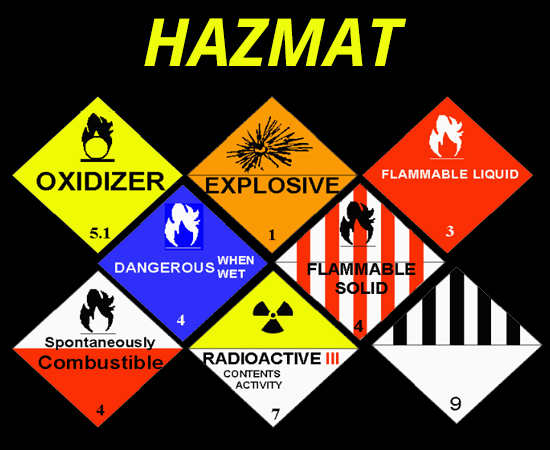
Hazardous Materials Incidents
Hazardous materials come in the form of explosives, flammable and combustible substances, poisons and radioactive materials. Hazards can occur during production, storage, transportation, use or disposal. You and your community are at risk if a chemical is used unsafely or released in harmful amounts into the environment where you live, work or play.
Before a Hazardous Materials Incident
Many communities have Local Emergency Planning Committees (LEPCs) whose responsibilities include collecting information about hazardous materials in the community and planning made available to the public upon request. Contact your local emergency management office for more information on LEPCs.
The following are things you can do to protect yourself, your family and your property from the effects of a hazardous materials incident:
- Build an Emergency Supply Kit with the addition of plastic sheeting and duct tape
- Make a Family Emergency Plan
- Know how to operate your home’s ventilation system
- Identify an above-ground shelter room with as few openings as possible.
- Read more about Sheltering in Place
During a Hazardous Materials Incident
Listen to local radio or television stations for detailed information and follow instructions carefully. Remember that some toxic chemicals are odorless.
|
If you are:
|
Then:
|
|
Asked to evacuate
|
- Do so immediately.
- Stay tuned to a radio or television for information on evacuation routes, temporary shelters, and procedures.
- If you have time, minimize contamination in the house by closing all windows, shutting all vents, and turning off attic fans.
- Take pre-assembled disaster supplies.
- Remember to help your neighbors who may require special assistance--infants, elderly people and people with access and functional needs.
|
|
Caught Outside
|
- Stay upstream, uphill, and upwind. In general, try to go at least one-half mile (usually 8-10 city blocks) from the danger area.
- Do not walk into or touch any spilled liquids, airborne mists, or condensed solid chemical deposits. Try not to inhale gases, fumes and smoke. If possible, cover mouth with a cloth or mask while leaving the area.
- Stay away from accident victims until the hazardous material has been identified.
|
|
In a motor vehicle
|
- Stop and seek shelter in a permanent building.
- If you must remain in your car, keep car windows and vents closed and shut off the air conditioner and heater.
|
|
Requested to stay indoors
|
- Bring pets inside.
- Close and lock all exterior doors and windows. Close vents, fireplace dampers, and as many interior doors as possible.
- Turn off air conditioners and ventilation systems, or set ventilation systems to 100 percent recirculation so that no outside air is drawn into the building.
- If gas or vapors could have entered the building, take shallow breaths through a cloth or a towel.
- Avoid eating or drinking any food or water that may be contaminated.
- Go into your pre-selected shelter room.
- Seal gaps under and around the following areas with wet towels, plastic sheeting, duct tape, wax paper or aluminum foil:
- Doorways and windows
- Air conditioning units
- Bathroom and kitchen exhaust fans
- Stove and dryer vents with duct tape and plastic sheeting
|
After a Hazardous Materials Incident
The following are guidelines for the period following a hazardous materials incident:
- Listen to local radio or television stations for the latest emergency information.
- Go to a designated public shelter if you have been told to evacuate or you feel it is unsafe to remain in your home. Text SHELTER + your ZIP code to 43362 (4FEMA) to find the nearest shelter in your area (example: shelter 12345).
- Act quickly if you have come in to contact with or have been exposed to hazardous chemicals.
- Follow decontamination instructions from local authorities.
- Seek medical treatment for unusual symptoms as soon as possible.
- Place exposed clothing and shoes in tightly sealed containers.
- Advise everyone who comes in to contact with you that you may have been exposed to a toxic substance.
- Return home only when authorities say it is safe. Open windows and vents and turn on fans to provide ventilation.
- Find out from local authorities how to clean up your land and property.
- Report any lingering vapors or other hazards to your local emergency services office.
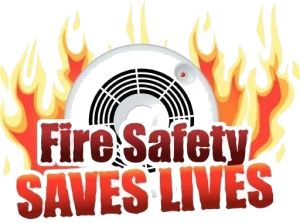
Home Fires
In just two minutes, a fire can become life-threatening. In five minutes, a residence can be engulfed in flames.
Learn About Fires
- Fire is FAST! In less than 30 seconds a small flame can turn into a major fire. It only takes minutes for thick black smoke to fill a house or for it to be engulfed in flames.
- Fire is HOT! Heat is more threatening than flames. Room temperatures in a fire can be 100 degrees at floor level and rise to 600 degrees at eye level. Inhaling this super-hot air will scorch your lungs and melt clothes to your skin.
- Fire is DARK! Fire starts bright, but quickly produces black smoke and complete darkness.
- Fire is DEADLY! Smoke and toxic gases kill more people than flames do. Fire produces poisonous gases that make you disoriented and drowsy. Asphyxiation is the leading cause of fire deaths, exceeding burns by a three-to-one ratio.
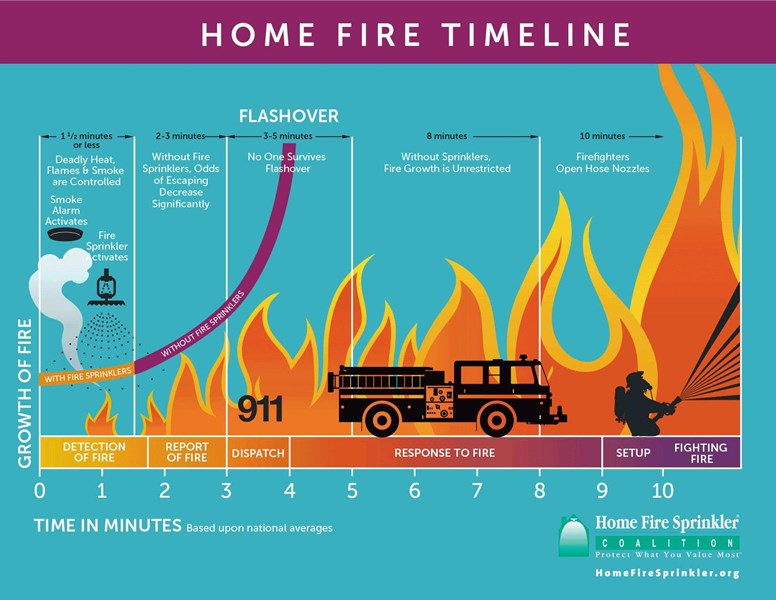
Before a Fire
Create and Practice a Fire Escape Plan
In the event of a fire, remember that every second counts, so you and your family must always be prepared. Escape plans help you get out of your home quickly.
Twice each year, practice your home fire escape plan. Some tips to consider when preparing this plan include:
- Find two ways to get out of each room in the event the primary way is blocked by fire or smoke.
- A secondary route might be a window onto a neighboring roof or a collapsible ladder for escape from upper story windows.
- Make sure that windows are not stuck, screens can be taken out quickly, and that security bars can be properly opened.
- Practice feeling your way out of the house in the dark or with your eyes closed.
- Teach children not to hide from firefighters.
Smoke Alarms
A working smoke alarm significantly increases your chances of surviving a deadly home fire.
- Install both ionization AND photoelectric smoke alarms, OR dual sensor smoke alarms, which contain both ionization and photoelectric smoke sensors.
- Test batteries monthly.
- Replace batteries in battery-powered and hard-wired smoke alarms at least once a year (except non-replaceable 10-year lithium batteries).
- Install smoke alarms on every level of your home, including the basement, both inside and outside of sleeping areas.
- Replace the entire smoke alarm unit every 8-10 years or according to manufacturer’s instructions.
- Never disable a smoke alarm while cooking – it can be a deadly mistake.
Smoke Alarm Safety for People with Access or Functional Needs
- Audible alarms for visually impaired people should pause with a small window of silence between each successive cycle so that they can listen to instructions or voices of others.
- Smoke alarms with a vibrating pad or flashing light are available for the hearing impaired. Contact your local fire department for information about obtaining a flashing or vibrating smoke alarm.
- Smoke alarms with a strobe light outside the home to catch the attention of neighbors, and emergency call systems for summoning help, are also available.
More Fire Safety Tips
- Make digital copies of valuable documents and records like birth certificates.
- Sleep with your door closed.
- Contact your local fire department for information on training on the proper use and maintenance of fire extinguishers.
- Consider installing an automatic fire sprinkler system in your residence.
During a Fire
- Crawl low under any smoke to your exit - heavy smoke and poisonous gases collect first along the ceiling.
- Before opening a door, feel the doorknob and door. If either is hot, or if there is smoke coming around the door, leave the door closed and use your second way out.
- If you open a door, open it slowly. Be ready to shut it quickly if heavy smoke or fire is present.
- If you can’t get to someone needing assistance, leave the home and call 9-1-1 or the fire department. Tell the emergency operator where the person is located.
- If pets are trapped inside your home, tell firefighters right away.
- If you can’t get out, close the door and cover vents and cracks around doors with cloth or tape to keep smoke out. Call 9-1-1 or your fire department. Say where you are and signal for help at the window with a light-colored cloth or a flashlight.
- If your clothes catch fire, stop, drop, and roll – stop immediately, drop to the ground, and cover your face with your hands. Roll over and over or back and forth until the fire is out. If you or someone else cannot stop, drop, and roll, smother the flames with a blanket or towel. Use cool water to treat the burn immediately for 3 to 5 minutes. Cover with a clean, dry cloth. Get medical help right away by calling 9-1-1 or the fire department.
Fire Escape Planning for Older Adults and People with Access or Functional Needs
- Live near an exit. You'll be safest on the ground floor if you live in an apartment building. If you live in a multi-story home, arrange to sleep on the ground floor, and near an exit.
- If you use a walker or wheelchair, check all exits to be sure you get through the doorways.
- Make any necessary accommodations, such as providing exit ramps and widening doorways, to facilitate an emergency escape.
- Speak to your family members, building manager, or neighbors about your fire safety plan and practice it with them.
- Contact your local fire department's non-emergency line and explain your special needs. Ask emergency providers to keep your special needs information on file.
- Keep a phone near your bed and be ready to call 911 or your local emergency number if a fire occurs.
After a Fire
The following checklist serves as a quick reference and guide for you to follow after a fire strikes.
- Contact your local disaster relief service, such as The Red Cross, if you need temporary housing, food and medicines.
- If you are insured, contact your insurance company for detailed instructions on protecting the property, conducting inventory and contacting fire damage restoration companies. If you are not insured, try contacting private organizations for aid and assistance.
- Check with the fire department to make sure your residence is safe to enter. Be watchful of any structural damage caused by the fire.
- The fire department should see that utilities are either safe to use or are disconnected before they leave the site. DO NOT attempt to reconnect utilities yourself.
- Conduct an inventory of damaged property and items. Do not throw away any damaged goods until after an inventory is made.
- Try to locate valuable documents and records. Refer to information on contacts and the replacement process inside this brochure.
- Begin saving receipts for any money you spend related to fire loss. The receipts may be needed later by the insurance company and for verifying losses claimed on income tax.
- Notify your mortgage company of the fire.
Prevent Home Fires
Home fires are preventable! The following are simple steps that each of us can take to prevent a tragedy.
Cooking
- Stay in the kitchen when you are frying, grilling, or broiling food. If you leave the kitchen for even a short period of time, turn off the stove.
- Wear short, close-fitting or tightly rolled sleeves when cooking.
- Keep children away from cooking areas by enforcing a "kid-free zone" of 3 feet around the stove.
- Position barbecue grills at least 10 feet away from siding and deck railings, and out from under eaves and overhanging branches.
Smoking
- Smoke outside and completely stub out butts in an ashtray or a can filled with sand.
- Soak cigarette butts and ashes in water before throwing them away. Never toss hot cigarette butts or ashes in the trash can.
- Never smoke in a home where oxygen is used, even if it is turned off. Oxygen can be explosive and makes fire burn hotter and faster.
- Be alert - don’t smoke in bed! If you are sleepy, have been drinking, or have taken medicine that makes you drowsy, put your cigarette out first.
Electrical and Appliance Safety
- Frayed wires can cause fires. Replace all worn, old or damaged appliance cords immediately and do not run cords under rugs or furniture.
- If an appliance has a three-prong plug, use it only in a three-slot outlet. Never force it to fit into a two-slot outlet or extension cord.
- Immediately shut off, then professionally replace, light switches that are hot to the touch and lights that flicker.
Portable Space Heaters
- Keep combustible objects at least three feet away from portable heating devices.
- Buy only heaters evaluated by a nationally recognized laboratory, such as Underwriters Laboratories (UL).
- Check to make the portable heater has a thermostat control mechanism, and will switch off automatically if the heater falls over.
- Only use crystal clear K-1 kerosene in kerosene heaters. Never overfill it. Use the heater in a well-ventilated room.
Fireplaces and Woodstoves
- Inspect and clean woodstove pipes and chimneys annually and check monthly for damage or obstructions.
- Use a fireplace screen heavy enough to stop rolling logs and big enough to cover the entire opening of the fireplace to catch flying sparks.
- Make sure the fire is completely out before leaving the house or going to bed.
Children
- Take the mystery out of fire play by teaching children that fire is a tool, not a toy.
- Store matches and lighters out of children's reach and sight, preferably in a locked cabinet.
- Never leave children unattended near operating stoves or burning candles, even for a short time.
More Prevention Tips
- Never use stove range or oven to heat your home.
- Keep combustible and flammable liquids away from heat sources.
- Portable generators should NEVER be used indoors and should only be refueled outdoors or in well ventilated areas.
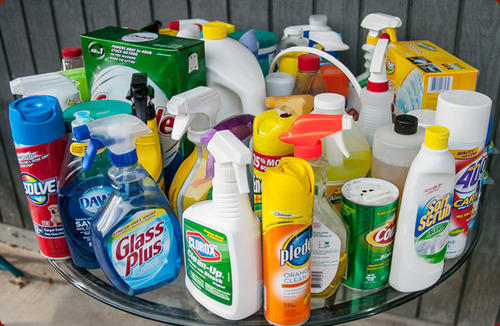
Household Chemical Emergencies
Although the risk of a chemical accident is slight, knowing how to handle household products containing hazardous materials or chemicals can reduce the risk of injury.
Before a Household Chemical Emergency
It is critical to store household chemicals in places where children cannot access them. Remember that products such as aerosol cans of hair spray and deodorant, nail polish and nail polish remover, toilet bowl cleaners and furniture polishes all fall into the category of hazardous materials.
Hazardous household chemicals may include:
- Cleaning products
- Pesticides
- Automotive products like antifreeze or motor oil
- Miscellaneous items like batteries, mercury thermometers and florescent light bulbs
- Flammable products like kerosene, home heating oil, propane tanks and lighter fluid
- Workshop or painting supplies such as paint thinners and turpentine
- Lawn and garden products like herbicides and insecticides
The following are guidelines for buying and storing hazardous household chemicals safely:
- Keep products containing hazardous materials in their original containers and never remove the labels unless the container is corroding. Corroding containers should be repackaged and clearly labeled.
- Never store hazardous products in food containers.
- Never mix household hazardous chemicals or waste with other products. Incompatibles, such as chlorine bleach and ammonia, may react, ignite or explode.
- Never use hair spray, cleaning solutions, paint products, or pesticides near an open flame
- Clean up any chemical spill immediately. Allow the fumes in the rags to evaporate outdoors, then dispose of the rags by wrapping them in a newspaper and placing them in a sealed plastic bag in your trash can.
- Dispose of hazardous materials correctly.
- Save the national poison control number in your cell phone and post it next to landlines in your home (800) 222-1222.
During a Household Chemical Emergency
Get out of the residence immediately if there is a danger of fire or explosion.
- Stay upwind and away from the residence to avoid breathing toxic fumes.
- Recognize and respond to symptoms of toxic poisoning including:
- Difficulty breathing
- Irritation of the eyes, skin, throat, or respiratory tract
- Changes in skin color
- Headache or blurred vision
- Dizziness, clumsiness or lack of coordination
- Cramps or diarrhea
- If someone is experiencing toxic poisoning symptoms or has been exposed to a household chemical, call the national poison control center at 1 (800) 222-1222 and find any containers of the substance that are readily available in order to provide requested information.
- Follow the emergency operator or dispatcher’s first aid instructions carefully. The first aid advice found on containers may be out of date or inappropriate. Do not give anything by mouth unless advised to do so by a medical professional.
After a Household Chemical Emergency
Discard clothing that may have been contaminated. Some chemicals may not wash out completely.

Nuclear Explosion
Nuclear explosions can cause significant damage and casualties from blast, heat, and radiation but you can keep your family safe by knowing what to do and being prepared if it occurs.
A nuclear weapon is a device that uses a nuclear reaction to create an explosion.
Nuclear devices range from a small portable device carried by an individual to a weapon carried by a missile.
A nuclear explosion may occur with or without a few minutes warning.
Fallout is most dangerous in the first few hours after the detonation when it is giving off the highest levels of radiation. It takes time for fallout to arrive back to ground level, often more than 15 minutes for areas outside of the immediate blast damage zones. This is enough time for you to be able to prevent significant radiation exposure by following these simple steps:
GET INSIDE
Get inside the nearest building to avoid radiation. Brick or concrete are best.
Remove contaminated clothing and wipe off or wash unprotected skin if you were outside after the fallout arrived.
Go to the basement or middle of the building. Stay away from the outer walls and roof.
STAY INSIDE
Stay inside for 24 hours unless local authorities provide other instructions.
Family should stay where they are inside. Reunite later to avoid exposure to dangerous radiation.
Keep your pets inside.
STAY TUNED
Tune into any media available for official information such as when it is safe to exit and where you should go.
Battery operated and hand crank radios will function after a nuclear detonation.
Cell phone, text messaging, television, and internet services may be disrupted or unavailable.
HOW TO STAY SAFE IN THE EVENT OF A NUCLEAR EXPLOSION
Prepare NOW
Identify shelter locations. Identify the best shelter location near where you spend a lot of time, such as home, work, and school. The best locations are underground and in the middle of larger buildings.
While commuting, identify appropriate shelters to seek in the event of a detonation.
Outdoor areas, vehicles, mobile homes do NOT provide adequate shelter. Look for basements or the center of large multistory buildings.
Make sure you have an Emergency Supply Kit for places you frequent and might have to stay for 24 hours. It should include bottled water, packaged foods, emergency medicines, a hand-crank or battery-powered radio to get information in case power is out, a flashlight, and extra batteries for essential items. If possible, store supplies for three or more days.
Survive DURING
If warned of an imminent attack, immediately get inside the nearest building and move away from windows. This will help provide protection from the blast, heat, and radiation of the detonation.
If you are outdoors when a detonation occurs take cover from the blast behind anything that might offer protection. Lie face down to protect exposed skin from the heat and flying debris. If you are in a vehicle, stop safely, and duck down within the vehicle.
After the shock wave passes, get inside the nearest, best shelter location for protection from potential fallout. You will have 10 minutes or more to find an adequate shelter.
Be inside before the fallout arrives. The highest outdoor radiation levels from fallout occur immediately after the fallout arrives and then decrease with time.
Stay tuned for updated instructions from emergency response officials. If advised to evacuate, listen for information about routes, shelters, and procedures.
If you have evacuated, do not return until you are told it is safe to do so by local officials.
Be Safe AFTER
Immediately after you are inside shelter, if you may have been outside after the fallout arrived:
Remove your outer layer of contaminated clothing to remove fallout and radiation from your body.
Take a shower or wash with soap and water to remove fallout from any skin or hair that was not covered. If you cannot wash or shower, use a wipe or clean wet cloth to wipe any skin or hair that was not covered.
Clean any pets that were outside after the fallout arrived. Gently brush your pet’s coat to remove any fallout particles and wash your pet with soap and water, if available.
It is safe to eat or drink packaged food items or items that were inside a building. Do not consume food or liquids that were outdoors uncovered and may be contaminated by fallout.
If you are sick or injured, listen for instructions on how and where to get medical attention when authorities tell you it is safe to exit.
Hazards related to nuclear explosions
- Bright FLASH can cause temporary blindness for less than a minute.
- BLAST WAVE can cause death, injury, and damage to structures several miles out from the blast.
- RADIATION can damage cells of the body. Large exposures can cause radiation sickness.
- FIRE AND HEAT can cause death, burn injuries, and damage to structures several miles out.
- ELECTROMAGNETIC PULSE (EMP) can damage electrical power equipment and electronics several miles out from the detonation and cause temporary disruptions further out.
- FALLOUT is radioactive, visible dirt and debris raining down from several miles up that can cause sickness to those who are outside.

Pandemic
This page will help you gather the information and resources you may need in case of a pandemic such as the flu.
Before a Pandemic
- Store a two week supply of water and food.
- Periodically check your regular prescription drugs to ensure a continuous supply in your home.
- Have any nonprescription drugs and other health supplies on hand, including pain relievers, stomach remedies, cough and cold medicines, fluids with electrolytes, and vitamins.
- Get copies and maintain electronic versions of health records from doctors, hospitals, pharmacies and other sources and store them, for personal reference. Get help accessing electronic help records.
- Talk with family members and loved ones about how they would be cared for if they got sick, or what will be needed to care for them in your home.
During a Pandemic
Limit the Spread of Germs and Prevent Infection
- Avoid close contact with people who are sick.
- When you are sick, keep your distance from others to protect them from getting sick too.
- Cover your mouth and nose with a tissue when coughing or sneezing. It may prevent those around you from getting sick.
- Washing your hands often will help protect you from germs.
- Avoid touching your eyes, nose or mouth.
- Practice other good health habits. Get plenty of sleep, be physically active, manage your stress, drink plenty of fluids, and eat nutritious food.
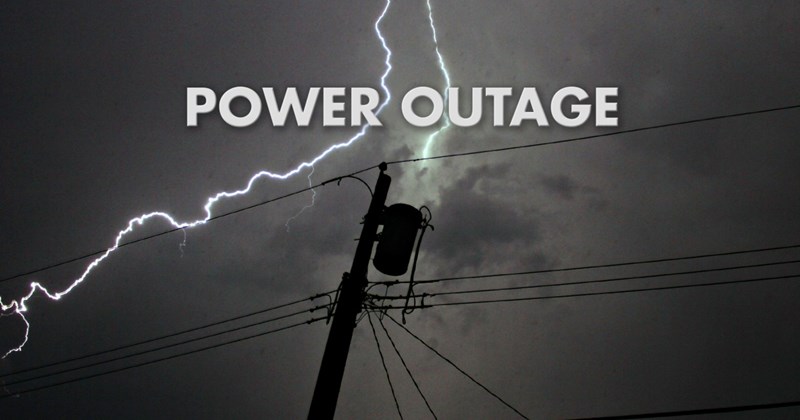
Power Outages
Extended power outages may impact the whole community and the economy. A power outage is when the electrical power goes out unexpectedly. A power outage may:
- Disrupt communications, water, and transportation.
- Close retail businesses, grocery stores, gas stations, ATMs, banks, and other services.
- Cause food spoilage and water contamination.
- Prevent use of medical devices.
PROTECT YOURSELF DURING A POWER OUTAGE:
- Keep freezers and refrigerators closed.
- Only use generators outdoors and away from windows.
- Do not use a gas stove to heat your home.
- Disconnect appliances and electronics to avoid damage from electrical surges.
- Have alternate plans for refrigerating medicines or using power-dependent medical devices.
- If safe, go to an alternate location for heat or cooling.
- Check on neighbors.
HOW TO STAY SAFE WHEN A POWER OUTAGE THREATENS:
Prepare NOW
- Take an inventory of the items you need that rely on electricity.
- Talk to your medical provider about a power outage plan for medical devices powered by electricity and refrigerated medicines. Find out how long medication can be stored at higher temperatures and get specific guidance for any medications that are critical for life.
- Plan for batteries and other alternatives to meet your needs when the power goes out.
- Sign up for local alerts and warning systems. Monitor weather reports.
- Install carbon monoxide detectors with battery backup in central locations on every level of your home.
- Determine whether your home phone will work in a power outage and how long battery backup will last.
- Review the supplies that are available in case of a power outage. Have flashlights with extra batteries for every household member. Have enough nonperishable food and water.
- Use a thermometer in the refrigerator and freezer so that you can know the temperature when the power is restored. Throw out food if the temperature is 40 degrees or higher.
- Keep mobile phones and other electric equipment charged and gas tanks full.
Survive DURING
- Keep freezers and refrigerators closed. The refrigerator will keep food cold for about four hours. A full freezer will keep the temperature for about 48 hours. Use coolers with ice if necessary. Monitor temperatures with a thermometer.
- Maintain food supplies that do not require refrigeration.
- Avoid carbon monoxide poisoning. Generators, camp stoves, or charcoal grills should always be used outdoors and at least 20 feet away from windows. Never use a gas stovetop or oven to heat your home.
- Check on your neighbors. Older adults and young children are especially vulnerable to extreme temperatures.
- Go to a community location with power if heat or cold is extreme.
- Turn off or disconnect appliances, equipment, or electronics. Power may return with momentary “surges” or “spikes” that can cause damage.
Be Safe AFTER
- When in doubt, throw it out! Throw away any food that has been exposed to temperatures 40 degrees or higher for two hours or more, or that has an unusual odor, color, or texture.
- If the power is out for more than a day, discard any medication that should be refrigerated, unless the drug’s label says otherwise. If a life depends on the refrigerated drugs, consult a doctor or pharmacist and use medicine only until a new supply is available.
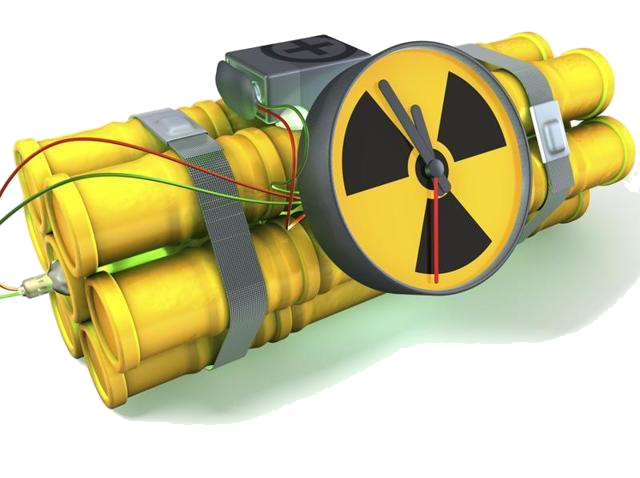
Radiological Dispersion Device
An RDD combines a conventional explosive device — such as a bomb — with radioactive material. It is designed to scatter dangerous and sub-lethal amounts of radioactive material over a general area.
Such RDDs appeal to terrorists because they require limited technical knowledge to build and deploy compared to a nuclear device. The size of the affected area and the level of destruction caused by an RDD would depend on the sophistication and size of the conventional bomb and other factors. The area affected could be placed off-limits to the public for several months during cleanup efforts.
Before an Radiological Dispersion Device (RDD) Event
There is no way of knowing how much warning time there will be before an attack by terrorists using a Radiological Dispersion Device (RDD), so being prepared in advance and knowing what to do and when is important. To prepare for an RDD event, you should do the following:
- Build an Emergency Supply Kit with the addition of duct tape and scissors.
- Make a Family Emergency Plan.
- Find out from officials if any public buildings in your community have been designated as fallout shelters. If none have been designated, make your own list of potential shelters near your home, workplace, and school, such as basements, subways, tunnels, or the windowless center area of middle floors in high-rise buildings.
- If you live in an apartment building or high-rise, talk to the manager about the safest place in the building for sheltering and about providing for building occupants until it is safe to go out.
Taking shelter during an RDD event is absolutely necessary. There are two kinds of shelters - blast and fallout. The following describes the two kinds of shelters:
- Blast shelters are specifically constructed to offer some protection against blast pressure, initial radiation, heat, and fire. But even a blast shelter cannot withstand a direct hit from a nuclear explosion.
- Fallout shelters do not need to be specially constructed for protecting against fallout. They can be any protected space, provided that the walls and roof are thick and dense enough to absorb the radiation given off by fallout particles.
During an Radiological Dispersion Device (RDD) Event
While the explosive blast will be immediately obvious, the presence of radiation will not be known until trained personnel with specialized equipment are on the scene.
If the explosion or radiological release occurs inside, get out immediately and seek safe shelter. Otherwise, if you are:
Outdoors
- Seek shelter indoors immediately in the nearest undamaged building.
- If appropriate shelter is not available, cover your nose and mouth and move as rapidly as is safe upwind, away from the location of the explosive blast. Then, seek appropriate shelter as soon as possible.
- Listen for official instructions and follow directions.
Indoors
- If you have time, turn off ventilation and heating systems, close windows, vents, fireplace dampers, exhaust fans, and clothes dryer vents.
- Retrieve your disaster supplies kit and a battery-powered radio and take them to your shelter room.
- Seek shelter immediately, preferably underground or in an interior room of a building, placing as much distance and dense shielding as possible between you and the outdoors where the radioactive material may be.
- Seal windows and external doors that do not fit snugly with duct tape to reduce infiltration of radioactive particles. Plastic sheeting will not provide shielding from radioactivity nor from blast effects of a nearby explosion.
- Listen for official instructions and follow directions.
After an Radiological Dispersion Device (RDD) Event
After finding safe shelter, those who may have been exposed to radioactive material should decontaminate themselves. To do this, remove and bag your clothing (and isolate the bag away from you and others), and shower thoroughly with soap and water. Seek medical attention after officials indicate it is safe to leave shelter.
Contamination from an RDD event could affect a wide area, depending on the amount of conventional explosives used, the quantity and type of radioactive material released, and meteorological conditions.
Follow these additional guidelines after an RDD event:
- Continue listening to your radio or watch the television for instructions from local officials, whether you have evacuated or sheltered-in-place.
- Do not return to or visit an RDD incident location for any reason.
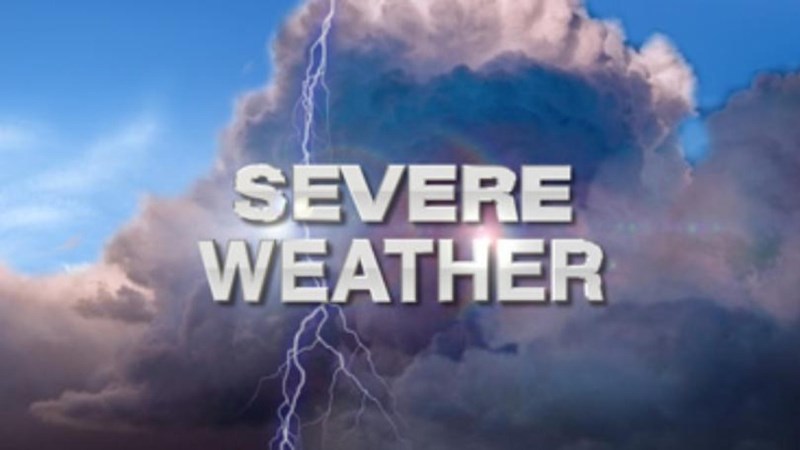
Severe Weather
Severe weather can happen anytime, in any part of the country. Severe weather can include hazardous conditions produced by thunderstorms, including damaging winds, tornadoes, large hail, flooding and flash flooding, and winter storms associated with freezing rain, sleet, snow and strong winds.
Know your Risk
Understand the type of hazardous weather that affects you and your family where you live:
Take Action
Develop an emergency plan based on your local weather hazards and practice your plan.
Snowstorms & Extreme Cold
Winter storms create a higher risk of car accidents, hypothermia, frostbite, carbon monoxide poisoning, and heart attacks from overexertion. Winter storms and blizzards can bring extreme cold, freezing rain, snow, ice, and high winds. A winter storm can:
- Last a few hours or several days;
- Knock out heat, power, and communication services; and
- Place older adults, young children, and sick individuals at greater risk.
IF YOU ARE UNDER A WINTER STORM WARNING, FIND SHELTER RIGHT AWAY
- Stay off roads.
- Stay indoors and dress warmly.
- Prepare for power outages.
- Use generators outside only and away from windows.
- Listen for emergency information and alerts.
- Look for signs of hypothermia and frostbite.
- Check on neighbors.
HOW TO STAY SAFE WHEN A WINTER STORM THREATENS:
Prepare NOW
- Know your area’s risk for winter storms. Extreme winter weather can leave communities without utilities or other services for long periods of time.
- Prepare your home to keep out the cold with insulation, caulking, and weather stripping. Learn how to keep pipes from freezing. Install and test smoke alarms and carbon monoxide detectors with battery backups.
- Pay attention to weather reports and warnings of freezing weather and winter storms. Sign up for your community’s warning system. The Emergency Alert System (EAS) and National Oceanic and Atmospheric Administration (NOAA) Weather Radio also provide emergency alerts.
- Gather supplies in case you need to stay home for several days without power. Keep in mind each person’s specific needs, including medication. Do not forget the needs of pets. Have extra batteries for radios and flashlights.
- Create an emergency supply kit for your car. Include jumper cables, sand, a flashlight, warm clothes, blankets, bottled water, and non-perishable snacks. Keep the gas tank full.
- Learn the signs of, and basic treatments for, frostbite and hypothermia.
13 Essentials for Your Winter Emergency Car Kit (+Checklist)
Early winter weather predictions call for warmer-than-average temperatures for most of the United States, but wetter conditions in the North. While snow sets the scene for a beautiful winter wonderland, it doesn’t make for fun driving conditions. Sleet and snow can reduce visibility and make it more difficult to control your vehicle on icy roadways. In fact, 17% of car accidents occur during winter weather conditions.
Low visibility, impassable roads, and extremely cold temperatures may even leave you stranded roadside in winter weather. Try to avoid driving in severe winter weather if you can, but for when you can’t avoid it, prepare with a winter car emergency kit in case you find yourself stuck. Find out what you should pack in your kit and how to protect yourself and your car this winter season.
Winter car emergency checklist
Items to keep in your car kit during the winter
Your winter emergency kit should include basic survival supplies, safety items, car maintenance tools, and winter clothing. These items will help you stay comfortable and hydrated if you ever get stuck on the side of the road or have to wait out a storm. Gather up your supplies, pack them into a storage bin or large backpack, and place your roadside emergency kit inside your car before venturing out into the cold weather.
1. Flashlight
Nighttime or near-blizzard conditions can decrease visibility to near-zero. A bright flashlight can provide much-needed light to either work on getting back on the road or signal to others for help. It’s smart to keep extra batteries in your emergency survival kit.
2. Bag of cat litter
For those new to winter weather, icy conditions greatly reduce your tire traction. To get your car unstuck, pour non-clumping kitty litter in the path of your tires. Other alternatives include sand or road salt.
3. Snow shovel
If snow starts piling up around your car on the side of the road, you’ll need a shovel to help you clear a path or uncover your car. Keep your car visible to rescue teams by limiting the amount of snow surrounding it or covering your tail lights.
4. First aid kit
A basic first aid kit can come in handy in the event of minor scrapes or pains, but even more so if you’re stranded. If you take daily medications, you should also pack extras away in your kit.
5. Ice scraper
People familiar with winter weather know how vital a windshield scraper is for getting ice and snow off of a windshield. During a deep freeze or emergency situation, you don’t want to waste time — or your car’s battery — waiting to defrost a thick sheet of ice on your windshield.
6. Jumper cables
Speaking of batteries, you’ll need to be able to jumpstart your car if the battery goes dead. While jumping a car is common, it can be dangerous if you don’t do it correctly. Most importantly, reduce the risk of sparking by never touching the clamps end to end and avoid any moisture near the cables.
7. Water
Dehydration is a serious threat when you’re stranded. Keep a large jug of water—preferably glass—in your car for emergencies. Replace the water every few months since it may go through extreme temperature changes inside your car.
8. Blanket
Pack a large, thick blanket away in your car to keep you warm in winter weather or to use as padding in case you need to work on your car. Consider adding a reflective emergency blanket or sleeping bag to your kit too.
9. Cell phone charger
This is essential for most drivers already but it won’t hurt to add an extra charger with a lighter adapter to your kit. Of course, this assumes you have enough gas and battery to keep your car running to get a charge so consider packing a portable phone charger too.
Print out an emergency contact sheet to keep in your car just in case your phone dies and you don’t have access to a charger. You may be able to borrow someone else’s phone to call for help or contact your loved ones to let them know you’re safe.
10. Reflective triangles
Breaking down on the side of the road can put you at risk for passing drivers, especially in low visibility conditions. Put out reflective triangles to make your car more visible and protect from any hazards.
11. Non-perishable snacks
Granola bars, nuts, crackers, dried fruit, and jerky are a few examples of snacks you can keep on hand in case you get stranded. Like the water, you should replace these every few months or sooner so they don’t expire.
12. Matches
Waterproof matches or a lighter can provide some light and warmth in case of emergency. These small items hardly take up any space in your kit too.
13. Toolkit
Similar to the first aid kit, a basic toolkit can be useful year-round in your car. From small repairs to changing a tire, keep these on hand in case you need them.
Other recommended items
For those who like to always be prepared, consider adding a few more items to your winter car emergency kit. Stock up with plenty of winter clothing like a hat, large coat, socks, and gloves to stay warm and dry.
Pack these additional supplies if you have space in your car:
- Extra winter clothes
- Snow boots
- Tire chains
- Duct tape
- Empty gas can
- Tow strap
- Fire extinguisher
- Road flare
- Snow brush
- Traction mats
Car maintenance tips to prepare for winter weather conditions
Just like your emergency kit, your vehicle should be prepped as winter approaches. Don’t wait for the temperature to drop to realize you should have had something repaired. Check off these routine maintenance items before hitting the road and driving in winter weather.
Swap your wiper blades
If your wiper blades are leaving streaks across your windshield, it may be time to replace them. You can purchase special winter wiper blades to battle heavy snow and ice.
Inspect your battery
Temperature drops can wreak havoc on your car battery. You may notice it’s more difficult to start your car in near-freezing temps because it loses cranking power. Either check out your battery’s charge level yourself or go to a local repair shop to have it inspected.
Keep gas in the tank
Being stuck out in a snowstorm with little to no gas is risky. Try to keep at least a half-tank of gas during winter months to avoid running out while you’re on the road. That way you can stay warm and charged up for when it’s safe to hit the road again.
Check your tires
Consider changing your regular tires to snow tires for the winter season. If you keep your regular ones on, check the tread and air pressure to ensure they’re properly inflated and not worn down. Don’t forget to check the spare tire as well!
Test your lights
Lights may dim or fog up over time, which doesn’t help visibility snowy conditions. Check that your turn signals and hazard lights work both in the front and back of your car. If they put out less light than usual, it may be time to clean out or replace the bulbs or wires.
Icy roadways and snowy conditions make driving dangerous even for those used to winter weather. Don’t hit the road unless you have to and for when you do have to go out, prepare with a winter car emergency kit just in case you get stranded out in the snow.
6 Winter driving tips to remember for the next winter storm
Driving is dangerous in the best of times, but snow and ice up the stakes. Don’t let winter driving hacks or lazy habits increase your risk of injury, theft, or getting a ticket. Be cautious and patient and power through ‘til spring!
1. Don’t idle your car first before driving it
The best thing to do to warm your car quickly during cold temperatures is to get in and drive. Most parts of modern engines can’t warm up just by idling.
Why does the idling myth persist? The idea dates back to the 1980s and 90s when carburetors (a formerly essential engine element that is no longer widely used) were the norm. Carburetors did need to be adequately warmed before driving in order to get the right mix of air and fuel into the engine. But now, electronic fuel injection, which relies on sensors to find the right mix of air and fuel, has replaced carburetors and warm-up idling is now irrelevant for both optimal engine performance and passenger cabin comfort. The only thing you’ll do by idling is waste gas and cause more pollution. Revving your engine to warm it up isn’t a good idea either because you risk damaging the engine.
2. Never pour boiling water on the windshield
You could actually break the windshield if you do. Glass cannot go from freezing to high temperatures quickly. If it does, it could shatter. And while you’re at it, don’t pour boiling water anywhere else on your car, either – you could shatter side windows or damage in-door electronic systems. During the winter months especially, if your windshield has even a small crack, have it repaired immediately as windshields are crucial to vehicle structural integrity. Luckily, many companies will replace your windshield right in your driveway (and many insurers will pay for it, too).
If you must drive before you’re able to get a cracked windshield repaired, do not blast the heat inside your car if the temperatures outside are low. A crack in glass could spread much more quickly with a sudden temperature contrast.
3. What to do—and NOT do—when you hydroplane or hit black ice
Hydroplaning occurs when your tires encounter more water than they can scatter so they lose direct contact with the road and your car skids or slides. You’re most likely to hydroplane during the first 10 minutes of rain or snow as oils and grease on the road mix with water and create extra slippery conditions. Still, hydroplaning can happen on wet roads at any point, so use caution. In cold weather conditions, you’re also at risk of hitting a patch of black ice, a transparent (read: invisible) coating of ice that forms during rainfall with temperatures at or below 32 degrees Fahrenheit.
Both experiences can be dangerous, but if you prepare ahead, you can avoid acting out of fear and instead take steps to continue safely on down the road:
Don’t accelerate or brake quickly because hydroplaning means you’ve lost traction with the road, and sudden changes in speed could cause you could spin out.
If you have front-wheel drive (with or without ABS and traction control) or rear-wheel drive with ABS and traction control, look for open space and plan to travel in that direction.
Accelerate just a little and steer gently – without sudden movements – in the direction of the open space.
If you have a rear-wheel drive without ABS or traction control, you should still head toward an open space, but instead of applying pressure to the accelerator, ease off it as you steer to the open space.
4. A tire chain primer for winter weather driving
Tire chains aren’t for the everyday urban or suburban driver. Not only are chains difficult to attach, but they’re also like driving on a car with square tires. That is, chains make for an incredibly uncomfortable ride. Plus, they must be removed once you find a clear stretch of road. In fact, the only people who probably need tire chains are those living in rural (read: unplowed) areas with several inches of snowfall or during extreme blizzard conditions. For those in other regions, consider keeping an extra shovel and some kitty litter in your car to help you steer out of snowy spots instead.
5. Never snow on your car or ice on your windshield
You’re in a hurry and you just want to get going. But no matter how rushed your morning has been, don’t forget to stop and wipe or shovel the snow off the top of your car before you start driving. Why? For one, a number of states have laws against driving with snow still on your car.
Further, the snow on the roof of your car could easily slide and block your windshield when you break. Or, if it flies off onto the car behind you, it can hurt their visibility or risk them getting into an accident. Some drivers have even been killed because of stray snow and ice from the top of a car.
6. Don't use fog lights when there’s no fog
Some vehicles have fog lights installed in addition to headlights, which are useful for seeing more clearly on foggy days (as the name makes clear). But using them in clear weather can be blinding to other cars on the road. Some states, therefore, have laws banning their use whenever it’s not foggy out. If it’s dark or rainy, stick to using your usual headlights (not your brights!) and save the fog lights for actual fog.
Survive DURING
- Stay off roads if at all possible. If trapped in your car, then stay inside.
- Limit your time outside. If you need to go outside, then wear layers of warm clothing. Watch for signs of frostbite and hypothermia.
- Avoid carbon monoxide poisoning. Only use generators and grills outdoors and away from windows. Never heat your home with a gas stovetop or oven.
- Reduce the risk of a heart attack. Avoid overexertion when shoveling snow.
- Watch for signs of frostbite and hypothermia and begin treatment right away.
- Check on neighbors. Older adults and young children are more at risk in extreme cold.
RECOGNIZE AND RESPOND
- Frostbite causes loss of feeling and color around the face, fingers, and toes.
- Signs: Numbness, white or grayish-yellow skin, firm or waxy skin
- Actions: Go to a warm room. Soak in warm water. Use body heat to warm. Do not massage or use a heating pad.
- Hypothermia is an unusually low body temperature. A temperature below 95 degrees is an emergency.
- Signs: Shivering, exhaustion, confusion, fumbling hands, memory loss, slurred speech, or drowsiness
- Actions: Go to a warm room. Warm the center of the body first—chest, neck, head, and groin. Keep dry and wrapped up in warm blankets, including the head and neck.

Space Weather
The term “space weather” refers to the variable conditions on the sun and in space that can influence the performance of technology we use on Earth.
Extreme space weather could potentially cause damage to critical infrastructure – especially the electric grid – highlighting the importance of being prepared.
Learn About Space Weather
In order to protect people and systems that might be at risk from space weather effects, we need to understand the causes of space weather.
The sun is the main source of space weather. Sudden bursts of plasma and magnetic field structures from the sun's atmosphere called coronal mass ejections (CME) together with sudden bursts of radiation, or solar flares, all cause space weather effects here on Earth.
Space weather can produce electromagnetic fields that induce extreme currents in wires, disrupting power lines, and even causing wide-spread blackouts. Severe space weather also produces solar energetic particles, which can damage satellites used for commercial communications, global positioning, intelligence gathering, and weather forecasting.
The strongest geomagnetic storm on record is the Carrington Event of August-September 1859, named after the British astronomer Richard Carrington. During this event currents electrified telegraph lines, shocking technicians and setting their telegraph papers on fire; and Northern Lights (electrically charged particles from the sun that enter Earth's atmosphere) were visible as far south as Cuba and Hawaii.
Another significant space weather event took place on March 13,1989; a powerful geomagnetic storm set off a major power blackout in Canada that left six million people without electricity for nine hours. According to the North American Electric Reliability Corporation (NERC), the flare disrupted electric power transmission from the Hydro Québec generating station and even melted some power transformers in New Jersey.
Predicting Space Weather
Space weather prediction services in the United States are provided primarily by NOAA's Space Weather Prediction Center (SWPC) and the U.S. Air Force's (USAF) Weather Agency (AFWA), which work closely together to address the needs of their civilian and military user communities. The SWPC draws on a variety of data sources, both space and ground-based, to provide forecasts, watches, warnings, alerts, and summaries as well as operational space weather products to civilian and commercial users.
Before Space Weather Occurs
Space weather can have an impact on our advanced technologies which has a direct impact on our daily lives. The main area of concern will most likely be our nation's electric power grid. Northern territories are more vulnerable to these effects than areas farther south. Generally, power outages due to space weather are very rare events, but evidence suggests that significant effects could occur. These power outages may have cascading effects, causing:
- Loss of water and wastewater distribution systems
- Loss of perishable foods and medications
- Loss of heating/air conditioning and electrical lighting systems
- Loss of computer systems, telephone systems, and communications systems (including disruptions in airline flights, satellite networks and GPS services)
- Loss of public transportation systems
- Loss of fuel distribution systems and fuel pipelines
- Loss of all electrical systems that do not have back-up power
To begin preparing, you should build an emergency kit and make a family communications plan. Other steps you can take include:
- Fill plastic containers with water and place them in the refrigerator and freezer if there's room. Leave about an inch of space inside each one, because water expands as it freezes. This chilled or frozen water will help keep food cold during a temporary power outage.
- Be aware that most medication that requires refrigeration can be kept in a closed refrigerator for several hours without a problem. If unsure, check with your physician or pharmacist.
- Keep your car tank at least half full because gas stations rely on electricity to power their pumps.
- Know where the manual release lever of your electric garage door opener is located and how to operate it. Garage doors can be heavy, so know that you may need help to lift it.
- Keep a key to your house with you if you regularly use the garage as the primary means of entering your home, in case the garage door will not open.
- Keep extra batteries for your phone in a safe place or purchase a solar-powered or hand crank charger. These chargers are good emergency tools to keep your laptop and other small electronics working in the event of a power outage. If you own a car, purchase a car phone charger because you can charge your phone if you lose power at your home.
- If you have a traditional landline (non-broadband or VOIP) phone, keep at least one non-cordless receiver in your home because it will work even if you lose power.
- Prepare a family contact sheet. This should include at least one out-of-town contact that may be better able to reach family members in an emergency.
- Make back-up copies of important digital data and information, automatically if possible, or at least weekly.
Space Weather Scales
The NOAA Space Weather Scales report three categories of solar effects. These scales communicate current and future space weather conditions, and their possible effects on people and systems. Similar to the Saffir-Simpson Hurricane Wind Scale, the NOAA space weather scales correlate space weather events with their likely effects on technological systems. As shown in the table below, the scales describe the environmental disturbances for three event types: Geomagnetic Storms (G-scale), Solar Radiation Storms (S-scale), and Radio Blackouts (R-scale). The scales have numbered levels, analogous to hurricanes, tornadoes, and earthquakes that convey severity.
|
Description of Space Weather Scale
|
|
Geomagnetic Storms: disturbances in the geomagnetic field caused by gusts in the solar wind that blows by Earth.
|
|
Minor -- Extreme
|
G1
|
|
|
G2
|
|
|
G3
|
|
|
G4
|
|
|
G5
|
|
Solar Radiation Storms: elevated levels of radiation that occur when the numbers of energetic particles increase.
|
|
Minor -- Extreme
|
S1
|
|
|
S2
|
|
|
S3
|
|
|
S4
|
|
|
S5
|
|
Radio Blackouts: disturbances of the ionosphere caused by X-ray emissions from the Sun.
|
|
Minor -- Extreme
|
R1
|
|
|
R2
|
|
|
R3
|
|
|
R4
|
|
|
R5
|
|
Description of Space Weather Scale
|
Minor -- Extreme
|
|
Geomagnetic Storms: disturbances in the geomagnetic field caused by gusts in the solar wind that blows by Earth.
|
G1
|
G2
|
G3
|
G4
|
G5
|
|
Solar Radiation Storms: elevated levels of radiation that occur when the numbers of energetic particles increase.
|
S1
|
S2
|
S3
|
S4
|
S5
|
|
Radio Blackouts: disturbances of the ionosphere caused by X-ray emissions from the Sun.
|
R1
|
R2
|
R3
|
R4
|
R5
|
NOTE: The vast majority of "5" level events will not cause catastrophic damages to the electric grid. On average, the Earth is impacted by such storms about four times during every 11-year solar cycle, so many large storms have impacted the planet since the Carrington Storm with much less signification impact.
For more information visit NOAA Space Weather Scales.
Know the Terms
Watches are used for making long-lead predictions of geomagnetic activity.
Warnings are used to raise the public's level of alertness based on an expectation that a space weather event is imminent.
Alerts indicate that the observed conditions, highlighted by the warnings, have crossed a preset threshold or that a space weather event has already started.
During Space Weather Occurrence
- Follow energy conservation measures to keep the use of electricity as low as possible, which can help power companies avoid imposing rolling blackouts during periods when the power grid is compromised.
- Follow the Emergency Alert System (EAS) instructions carefully.
- Disconnect electrical appliances if instructed to do so by local officials.
- Do not use the telephone unless absolutely necessary, during emergency situations keeping lines open for emergency personnel can improve response.
After Space Weather Occurrence
Throw out unsafe food:
- Throw away any food that has been exposed to a temperature of 40° F (4° C) or higher for 2 hours or more or that has an unusual odor, color, or texture. When in doubt, throw it out!
- Never taste food or rely on appearance or odor to determine its safety. Some foods may look and smell fine, but if they have been at room temperature too long, bacteria causing food-borne illnesses can start growing quickly. Some types of bacteria produce toxins that cannot be destroyed by cooking.
- If food in the freezer is colder than 40° F and has ice crystals on it, you can refreeze it.
- If you are not sure food is cold enough, take its temperature with a food thermometer.
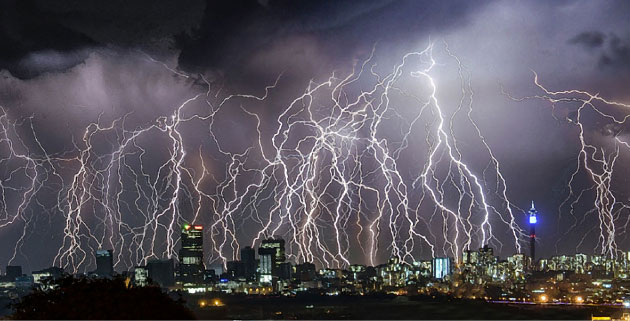
Thunderstorms & Lightning
Lightning is a leading cause of injury and death from weather-related hazards. Although most lightning victims survive, people struck by lightning often report a variety of long-term, debilitating symptoms. Thunderstorms are dangerous storms that include lightning and can:
IF YOU ARE UNDER A THUNDERSTORM WARNING, FIND SAFE SHELTER RIGHT AWAY
- When thunder roars, go indoors!
- Move from outdoors into a building or car.
- Pay attention to alerts and warnings.
- Unplug appliances.
- Do not use landline phones.
HOW TO STAY SAFE WHEN A THUNDERSTORM THREATENS
Prepare NOW
- Know your area’s risk for thunderstorms. In most places, they can occur year-round and at any hour.
- Sign up for your community’s warning system. The Emergency Alert System (EAS) and National Oceanic and Atmospheric Administration (NOAA) Weather Radio also provide emergency alerts.
- Identify nearby, sturdy buildings close to where you live, work, study, and play.
- Cut down or trim trees that may be in danger of falling on your home.
- Consider buying surge protectors, lightning rods, or a lightning protection system to protect your home, appliances, and electronic devices.
Survive DURING
- When thunder roars, go indoors. A sturdy building is the safest place to be during a thunderstorm.
- Pay attention to weather reports and warnings of thunderstorms. Be ready to change plans, if necessary, to be near shelter.
- When you receive a thunderstorm warning or hear thunder, go inside immediately.
- If indoors, avoid running water or using landline phones. Electricity can travel through plumbing and phone lines.
- Protect your property. Unplug appliances and other electric devices. Secure outside furniture.
- If boating or swimming, get to land and find a sturdy, grounded shelter or vehicle immediately.
- If necessary, take shelter in a car with a metal top and sides. Do not touch anything metal.
- Avoid flooded roadways. Turn Around. Don’t Drown! Just six inches of fast-moving water can knock you down, and one foot of moving water can sweep your vehicle away.
Be Safe AFTER
- Listen to authorities and weather forecasts for information on whether it is safe to go outside and instructions regarding potential flash flooding.
- Watch for fallen power lines and trees. Report them immediately.
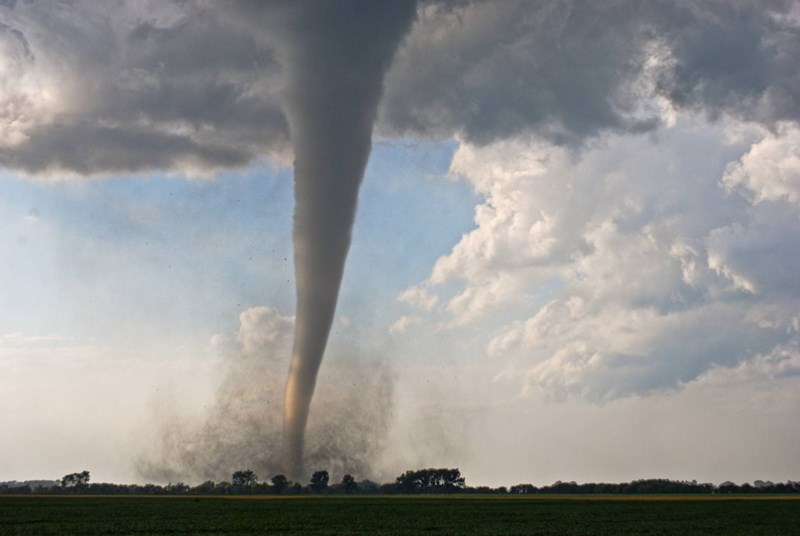
Tornadoes
Tornadoes can destroy buildings, flip cars, and create deadly flying debris. Tornadoes are violently rotating columns of air that extend from a thunderstorm to the ground. Tornadoes can:
- Happen anytime and anywhere;
- Bring intense winds, over 200 MPH; and
- Look like funnels.
IF YOU ARE UNDER A TORNADO WARNING, FIND SAFE SHELTER RIGHT AWAY
- If you can safely get to a sturdy building, then do so immediately.
- Go to a safe room, basement, or storm cellar.
- If you are in a building with no basement, then get to a small interior room on the lowest level.
- Stay away from windows, doors, and outside walls.
- Do not get under an overpass or bridge. You’re safer in a low, flat location.
- Watch out for flying debris that can cause injury or death.
- Use your arms to protect your head and neck.
HOW TO STAY SAFE WHEN A TORNADO THREATENS
Prepare NOW
- Know your area’s tornado risk. In the U.S., the Midwest and the Southeast have a greater risk for tornadoes.
- Know the signs of a tornado, including a rotating, funnel-shaped cloud; an approaching cloud of debris; or a loud roar—similar to a freight train.
- Sign up for your community’s warning system. The Emergency Alert System (EAS) and National Oceanic and Atmospheric Administration (NOAA) Weather Radio also provide emergency alerts. If your community has sirens, then become familiar with the warning tone.
- Pay attention to weather reports. Meteorologists can predict when conditions might be right for a tornado.
- Identify and practice going to a safe shelter in the event of high winds, such as a safe room built using FEMA criteria or a storm shelter built to ICC 500 standards. The next best protection is a small, interior, windowless room on the lowest level of a sturdy building.
- Consider constructing your own safe room that meets FEMA or ICC 500 standards.
Survive DURING
- Immediately go to a safe location that you identified.
- Take additional cover by shielding your head and neck with your arms and putting materials such as furniture and blankets around you.
- Listen to EAS, NOAA Weather Radio, or local alerting systems for current emergency information and instructions.
- Do not try to outrun a tornado in a vehicle.
- If you are in a car or outdoors and cannot get to a building, cover your head and neck with your arms and cover your body with a coat or blanket, if possible.
Be Safe AFTER
- Keep listening to EAS, NOAA Weather Radio, and local authorities for updated information.
- If you are trapped, cover your mouth with a cloth or mask to avoid breathing dust. Try to send a text, bang on a pipe or wall, or use a whistle instead of shouting.
- Stay clear of fallen power lines or broken utility lines.
- Do not enter damaged buildings until you are told that they are safe.
- Save your phone calls for emergencies. Phone systems are often down or busy after a disaster. Use text messaging or social media to communicate with family and friends.
- Be careful during clean-up. Wear thick-soled shoes, long pants, and work gloves.
Thank you for making your family and Franklin Park safe and ready, just in case!
